Strategic Management Report: Analyzing Sheng Siong's Market Position
VerifiedAdded on 2021/04/16
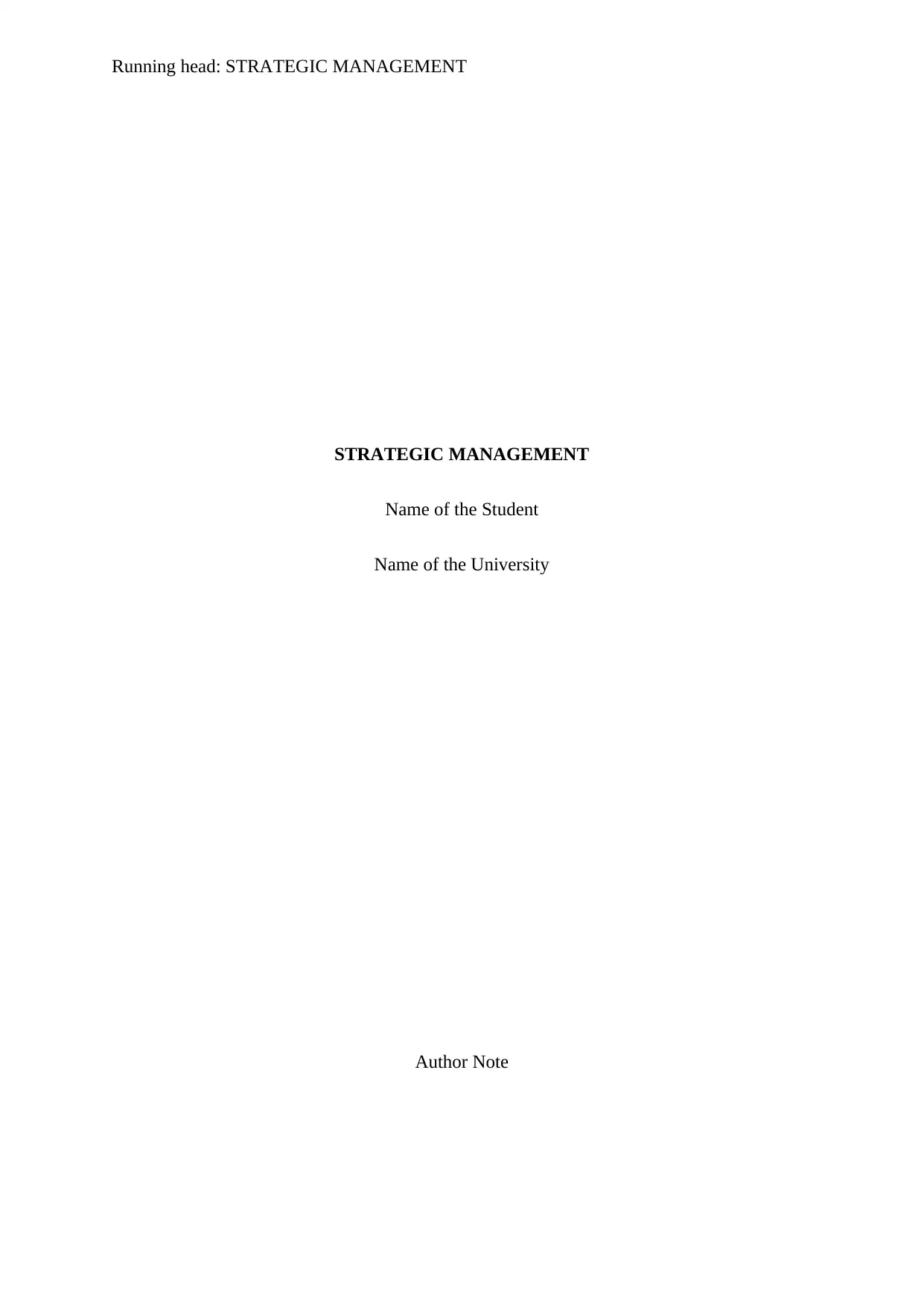
STRATEGIC MANAGEMENT
Name of the Student
Name of the University
Author Note
Paraphrase This Document
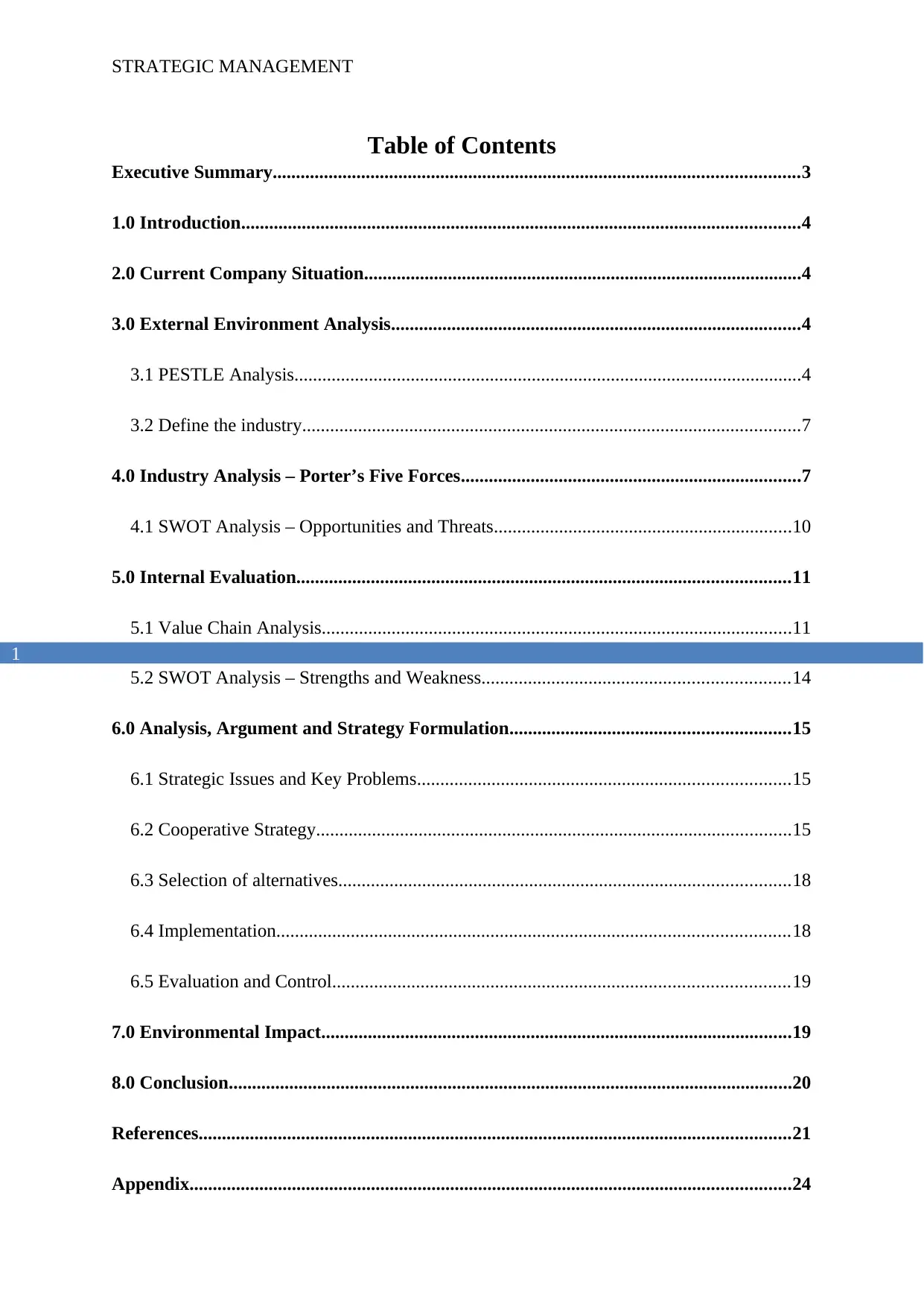
STRATEGIC MANAGEMENT
Table of Contents
Executive Summary.................................................................................................................3
1.0 Introduction........................................................................................................................4
2.0 Current Company Situation..............................................................................................4
3.0 External Environment Analysis........................................................................................4
3.1 PESTLE Analysis.............................................................................................................4
3.2 Define the industry...........................................................................................................7
4.0 Industry Analysis – Porter’s Five Forces.........................................................................7
4.1 SWOT Analysis – Opportunities and Threats................................................................10
5.0 Internal Evaluation..........................................................................................................11
5.1 Value Chain Analysis.....................................................................................................11
5.2 SWOT Analysis – Strengths and Weakness..................................................................14
6.0 Analysis, Argument and Strategy Formulation............................................................15
6.1 Strategic Issues and Key Problems................................................................................15
6.2 Cooperative Strategy......................................................................................................15
6.3 Selection of alternatives.................................................................................................18
6.4 Implementation..............................................................................................................18
6.5 Evaluation and Control..................................................................................................19
7.0 Environmental Impact.....................................................................................................19
8.0 Conclusion.........................................................................................................................20
References...............................................................................................................................21
Appendix.................................................................................................................................24

STRATEGIC MANAGEMENT
1. SWOT Analysis............................................................................................................24
2. PESTLE Analysis..........................................................................................................24
3. Ratio Analysis..................................................................................................................25
⊘ This is a preview!⊘
Do you want full access?
Subscribe today to unlock all pages.

Trusted by 1+ million students worldwide
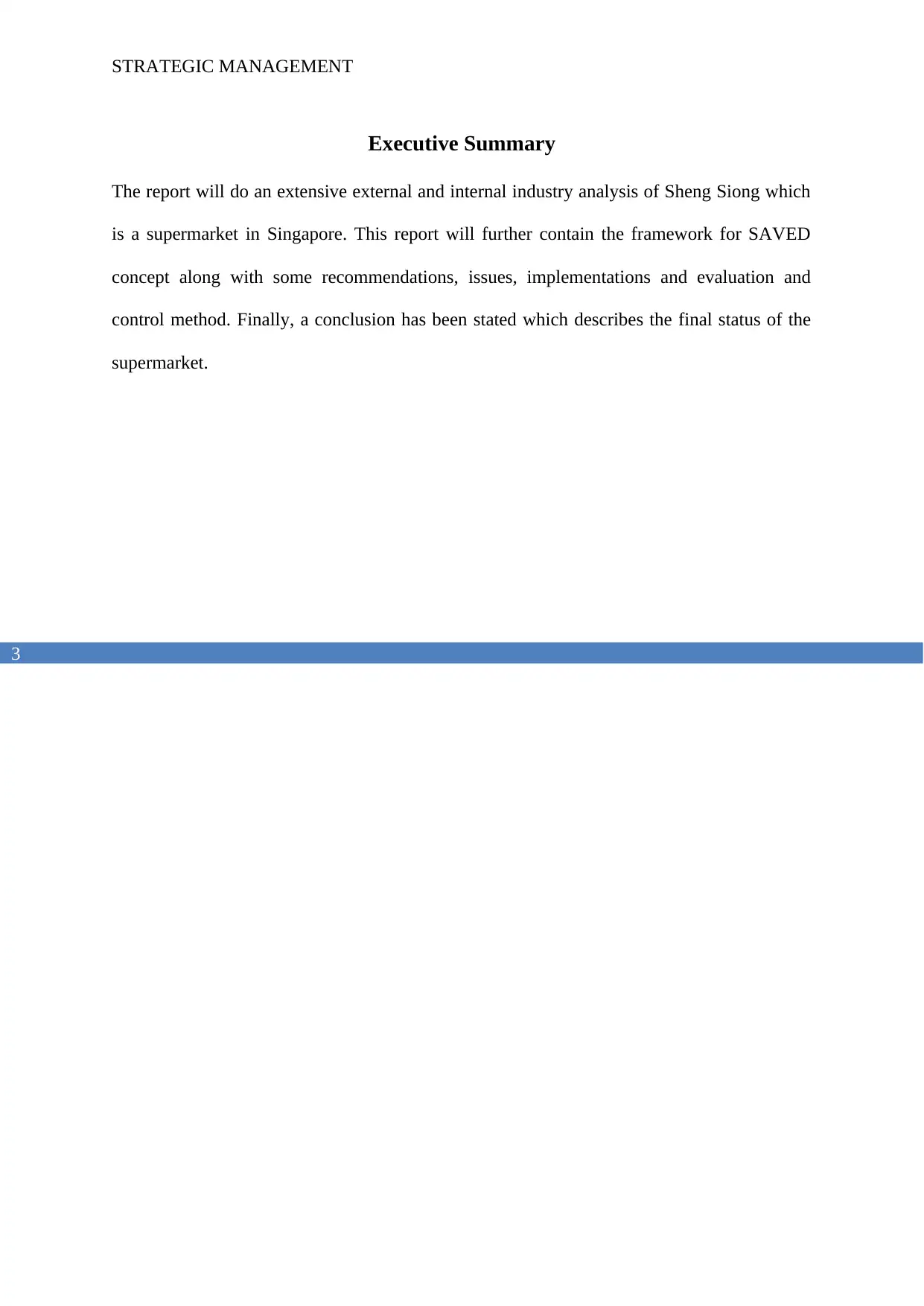
STRATEGIC MANAGEMENT
Executive Summary
The report will do an extensive external and internal industry analysis of Sheng Siong which
is a supermarket in Singapore. This report will further contain the framework for SAVED
concept along with some recommendations, issues, implementations and evaluation and
control method. Finally, a conclusion has been stated which describes the final status of the
supermarket.
Paraphrase This Document
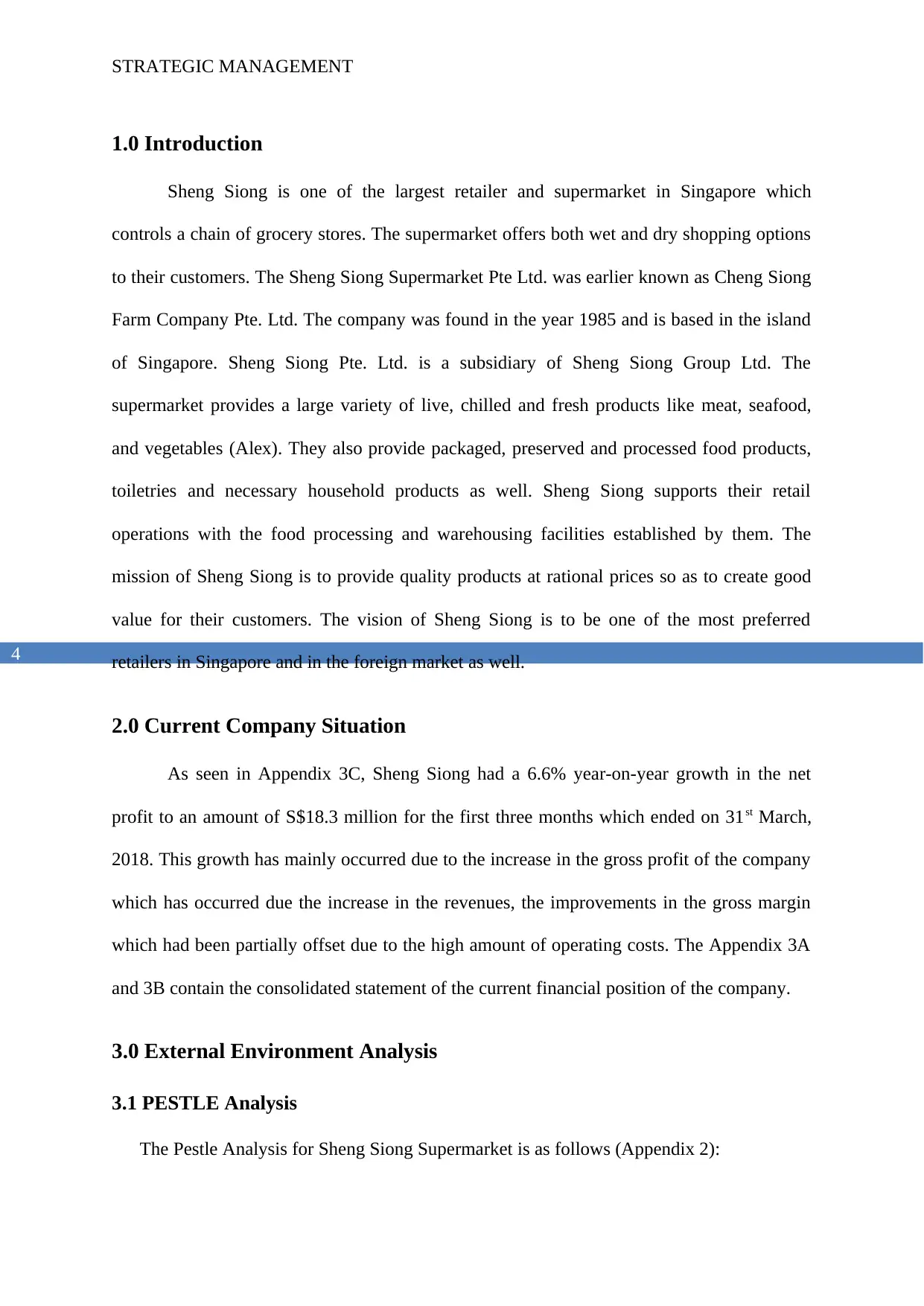
STRATEGIC MANAGEMENT
1.0 Introduction
Sheng Siong is one of the largest retailer and supermarket in Singapore which
controls a chain of grocery stores. The supermarket offers both wet and dry shopping options
to their customers. The Sheng Siong Supermarket Pte Ltd. was earlier known as Cheng Siong
Farm Company Pte. Ltd. The company was found in the year 1985 and is based in the island
of Singapore. Sheng Siong Pte. Ltd. is a subsidiary of Sheng Siong Group Ltd. The
supermarket provides a large variety of live, chilled and fresh products like meat, seafood,
and vegetables (Alex). They also provide packaged, preserved and processed food products,
toiletries and necessary household products as well. Sheng Siong supports their retail
operations with the food processing and warehousing facilities established by them. The
mission of Sheng Siong is to provide quality products at rational prices so as to create good
value for their customers. The vision of Sheng Siong is to be one of the most preferred
retailers in Singapore and in the foreign market as well.
2.0 Current Company Situation
As seen in Appendix 3C, Sheng Siong had a 6.6% year-on-year growth in the net
profit to an amount of S$18.3 million for the first three months which ended on 31st March,
2018. This growth has mainly occurred due to the increase in the gross profit of the company
which has occurred due the increase in the revenues, the improvements in the gross margin
which had been partially offset due to the high amount of operating costs. The Appendix 3A
and 3B contain the consolidated statement of the current financial position of the company.
3.0 External Environment Analysis
3.1 PESTLE Analysis
The Pestle Analysis for Sheng Siong Supermarket is as follows (Appendix 2):
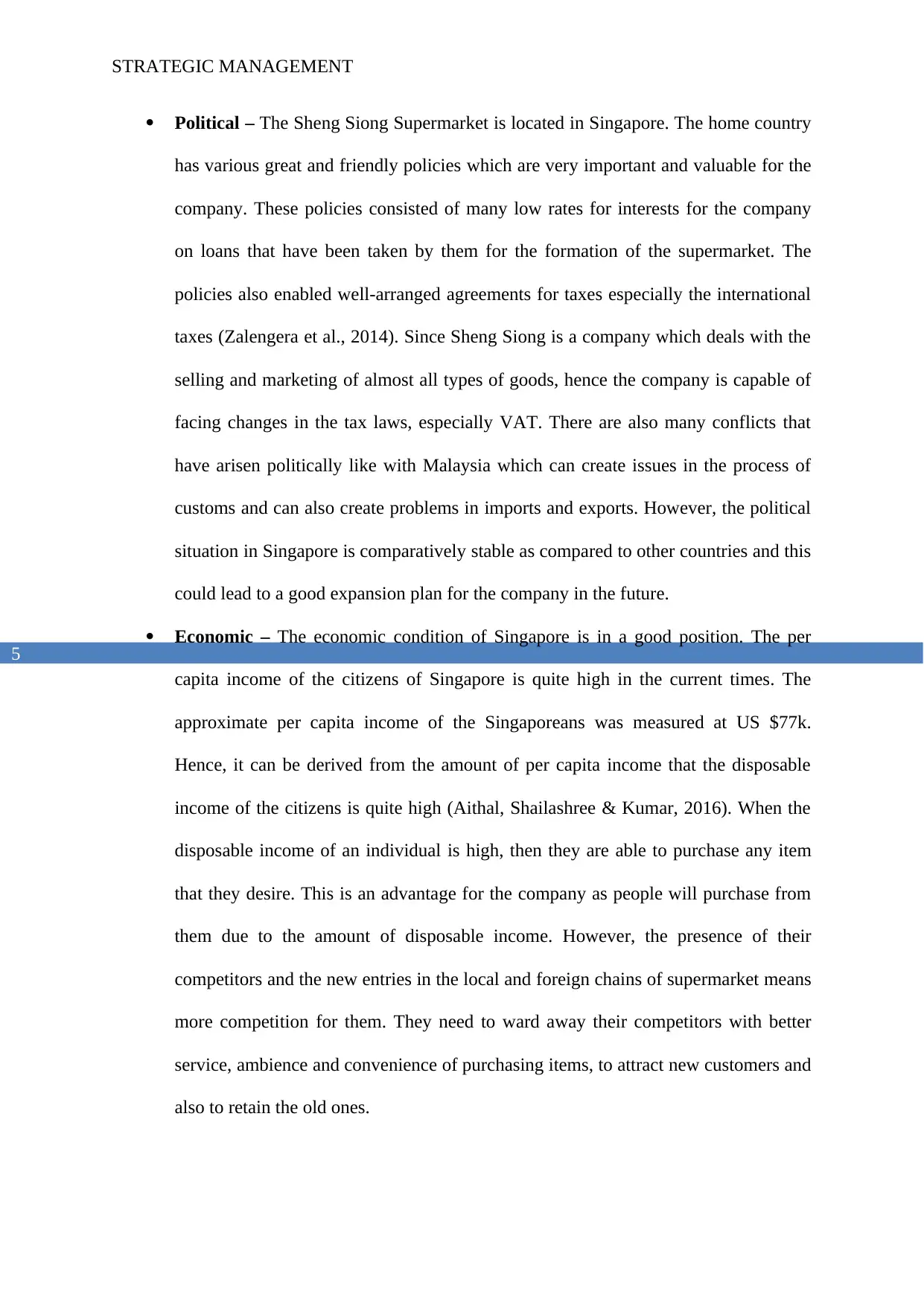
STRATEGIC MANAGEMENT
Political – The Sheng Siong Supermarket is located in Singapore. The home country
has various great and friendly policies which are very important and valuable for the
company. These policies consisted of many low rates for interests for the company
on loans that have been taken by them for the formation of the supermarket. The
policies also enabled well-arranged agreements for taxes especially the international
taxes (Zalengera et al., 2014). Since Sheng Siong is a company which deals with the
selling and marketing of almost all types of goods, hence the company is capable of
facing changes in the tax laws, especially VAT. There are also many conflicts that
have arisen politically like with Malaysia which can create issues in the process of
customs and can also create problems in imports and exports. However, the political
situation in Singapore is comparatively stable as compared to other countries and this
could lead to a good expansion plan for the company in the future.
Economic – The economic condition of Singapore is in a good position. The per
capita income of the citizens of Singapore is quite high in the current times. The
approximate per capita income of the Singaporeans was measured at US $77k.
Hence, it can be derived from the amount of per capita income that the disposable
income of the citizens is quite high (Aithal, Shailashree & Kumar, 2016). When the
disposable income of an individual is high, then they are able to purchase any item
that they desire. This is an advantage for the company as people will purchase from
them due to the amount of disposable income. However, the presence of their
competitors and the new entries in the local and foreign chains of supermarket means
more competition for them. They need to ward away their competitors with better
service, ambience and convenience of purchasing items, to attract new customers and
also to retain the old ones.
⊘ This is a preview!⊘
Do you want full access?
Subscribe today to unlock all pages.

Trusted by 1+ million students worldwide
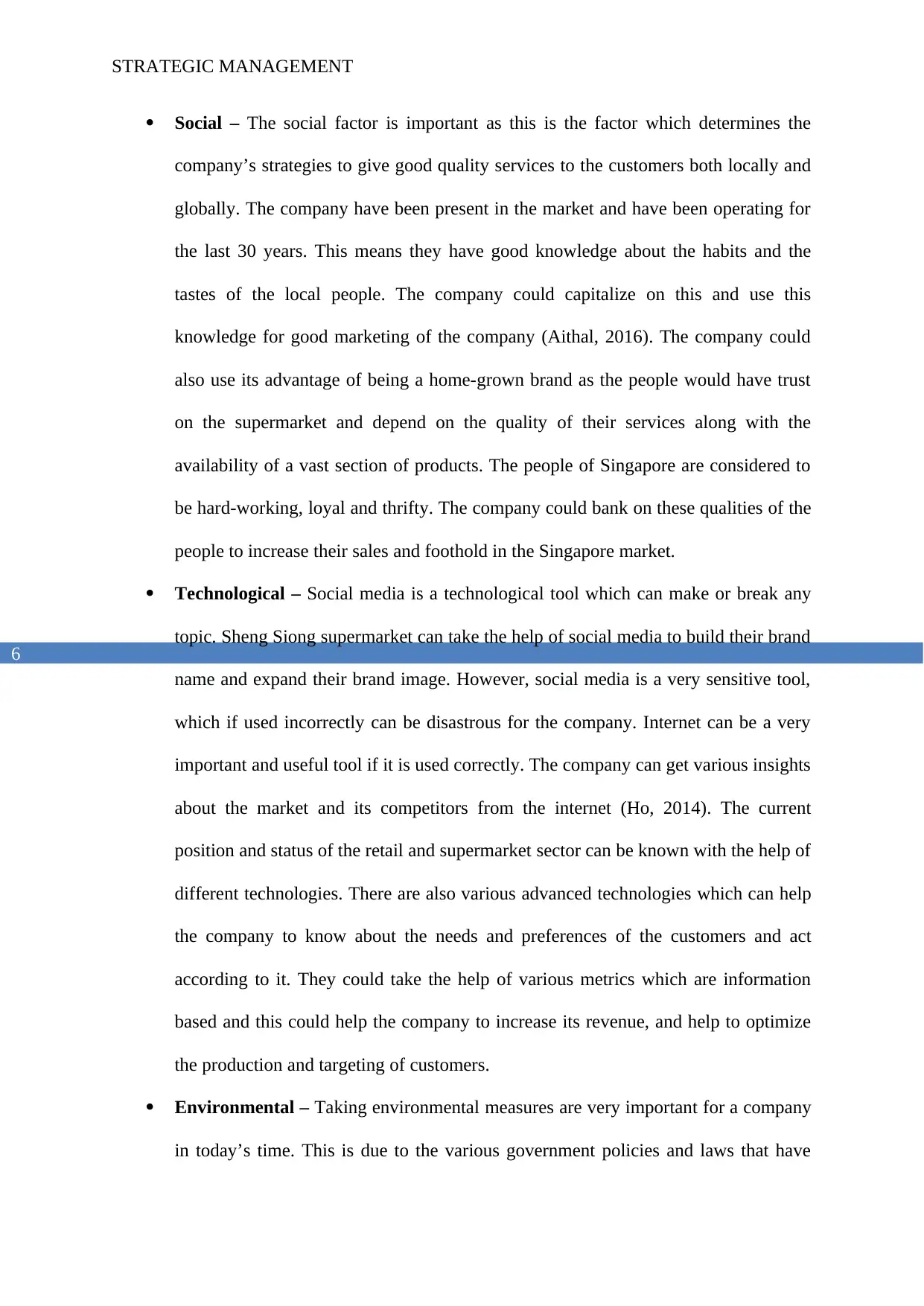
STRATEGIC MANAGEMENT
Social – The social factor is important as this is the factor which determines the
company’s strategies to give good quality services to the customers both locally and
globally. The company have been present in the market and have been operating for
the last 30 years. This means they have good knowledge about the habits and the
tastes of the local people. The company could capitalize on this and use this
knowledge for good marketing of the company (Aithal, 2016). The company could
also use its advantage of being a home-grown brand as the people would have trust
on the supermarket and depend on the quality of their services along with the
availability of a vast section of products. The people of Singapore are considered to
be hard-working, loyal and thrifty. The company could bank on these qualities of the
people to increase their sales and foothold in the Singapore market.
Technological – Social media is a technological tool which can make or break any
topic. Sheng Siong supermarket can take the help of social media to build their brand
name and expand their brand image. However, social media is a very sensitive tool,
which if used incorrectly can be disastrous for the company. Internet can be a very
important and useful tool if it is used correctly. The company can get various insights
about the market and its competitors from the internet (Ho, 2014). The current
position and status of the retail and supermarket sector can be known with the help of
different technologies. There are also various advanced technologies which can help
the company to know about the needs and preferences of the customers and act
according to it. They could take the help of various metrics which are information
based and this could help the company to increase its revenue, and help to optimize
the production and targeting of customers.
Environmental – Taking environmental measures are very important for a company
in today’s time. This is due to the various government policies and laws that have
Paraphrase This Document
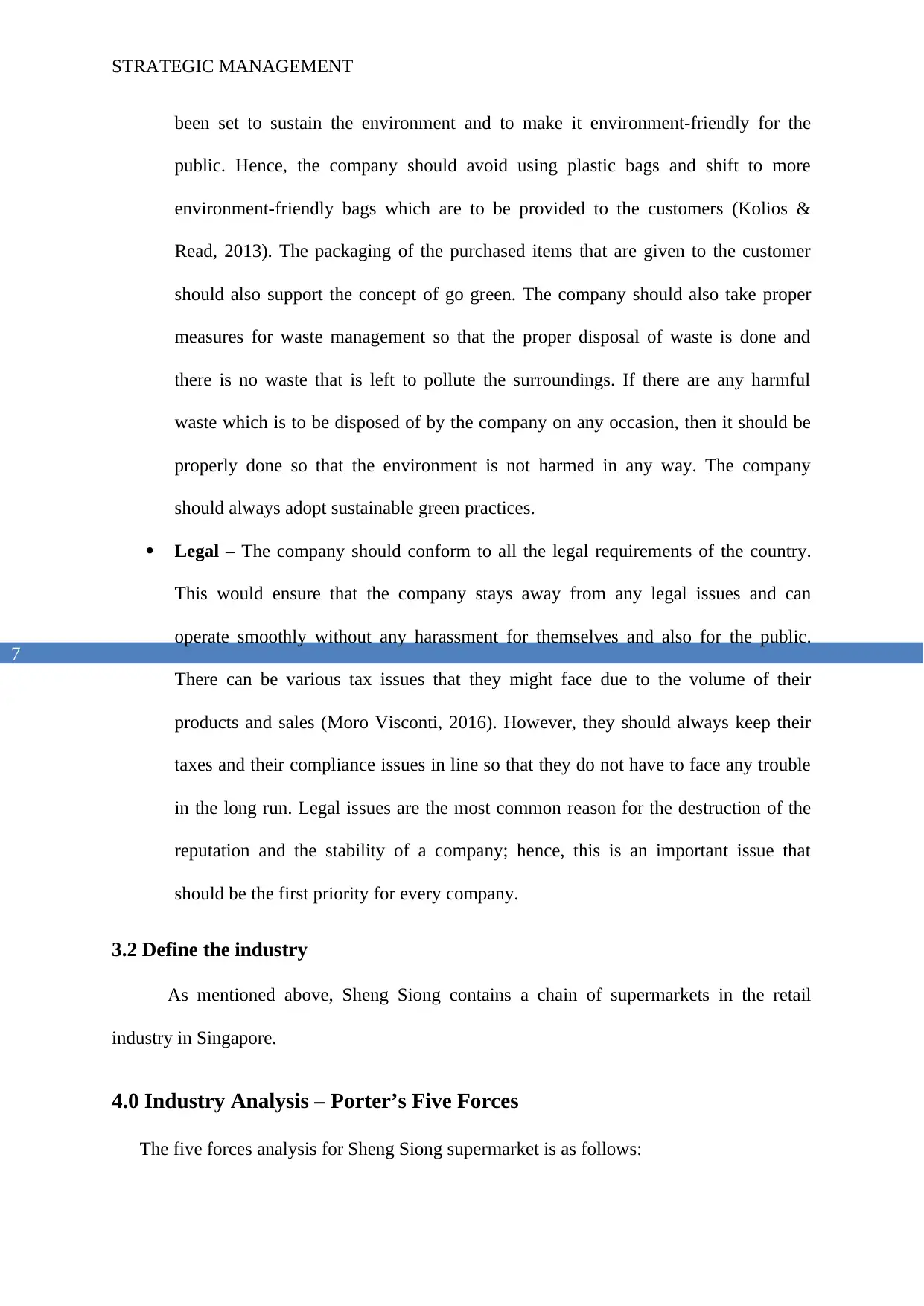
STRATEGIC MANAGEMENT
been set to sustain the environment and to make it environment-friendly for the
public. Hence, the company should avoid using plastic bags and shift to more
environment-friendly bags which are to be provided to the customers (Kolios &
Read, 2013). The packaging of the purchased items that are given to the customer
should also support the concept of go green. The company should also take proper
measures for waste management so that the proper disposal of waste is done and
there is no waste that is left to pollute the surroundings. If there are any harmful
waste which is to be disposed of by the company on any occasion, then it should be
properly done so that the environment is not harmed in any way. The company
should always adopt sustainable green practices.
Legal – The company should conform to all the legal requirements of the country.
This would ensure that the company stays away from any legal issues and can
operate smoothly without any harassment for themselves and also for the public.
There can be various tax issues that they might face due to the volume of their
products and sales (Moro Visconti, 2016). However, they should always keep their
taxes and their compliance issues in line so that they do not have to face any trouble
in the long run. Legal issues are the most common reason for the destruction of the
reputation and the stability of a company; hence, this is an important issue that
should be the first priority for every company.
3.2 Define the industry
As mentioned above, Sheng Siong contains a chain of supermarkets in the retail
industry in Singapore.
4.0 Industry Analysis – Porter’s Five Forces
The five forces analysis for Sheng Siong supermarket is as follows:

STRATEGIC MANAGEMENT
Rivalry among competitors – Singapore is a small island whose population is just
about 7 million. However, the supermarket sector in Singapore is very crowded as
compared to the population. There are many rivals of Sheng Siong both local and
international who wants to gain a strong foothold in the island. The strategy of the
company to beat their rivals is to set up their stores and expand themselves in various
locations (Dobbs, 2014). These locations are the ones where the Singaporean
government have planned to build public estates. This could turn out to be beneficial
for the company as they will be able to provide their services to the customers in the
locations that they will be present and hence the customers will not have to travel
very far. This becomes a competitive advantage for Sheng Siong supermarket and
helps them to maintain their status in the Singaporean supermarket industry in the
long run.
Bargaining power of suppliers – Sheng Siong is a supermarket which has many
branches and hence it has a long and vast reach on the island of Singapore. This has
enabled the supermarket to have a strong hold over its suppliers. The target audience
of the supermarket are the low to the middle-income families. Therefore, it has to
always keep in mind that the products which they sell in their store have to be of
affordable prices so as to match the income group of the market it has positioned
itself in (Dälken, 2014). The supermarket has good bargaining power over its
suppliers as there are many suppliers not a single one from whom they get their
products. Furthermore, due to the magnitude of the suppliers, the supermarket can
benefit from the switching costs of the many firms present in the market, the
existence of the substitutes of the products they sell and the cost of supply purchase
of those substitutes.
⊘ This is a preview!⊘
Do you want full access?
Subscribe today to unlock all pages.

Trusted by 1+ million students worldwide
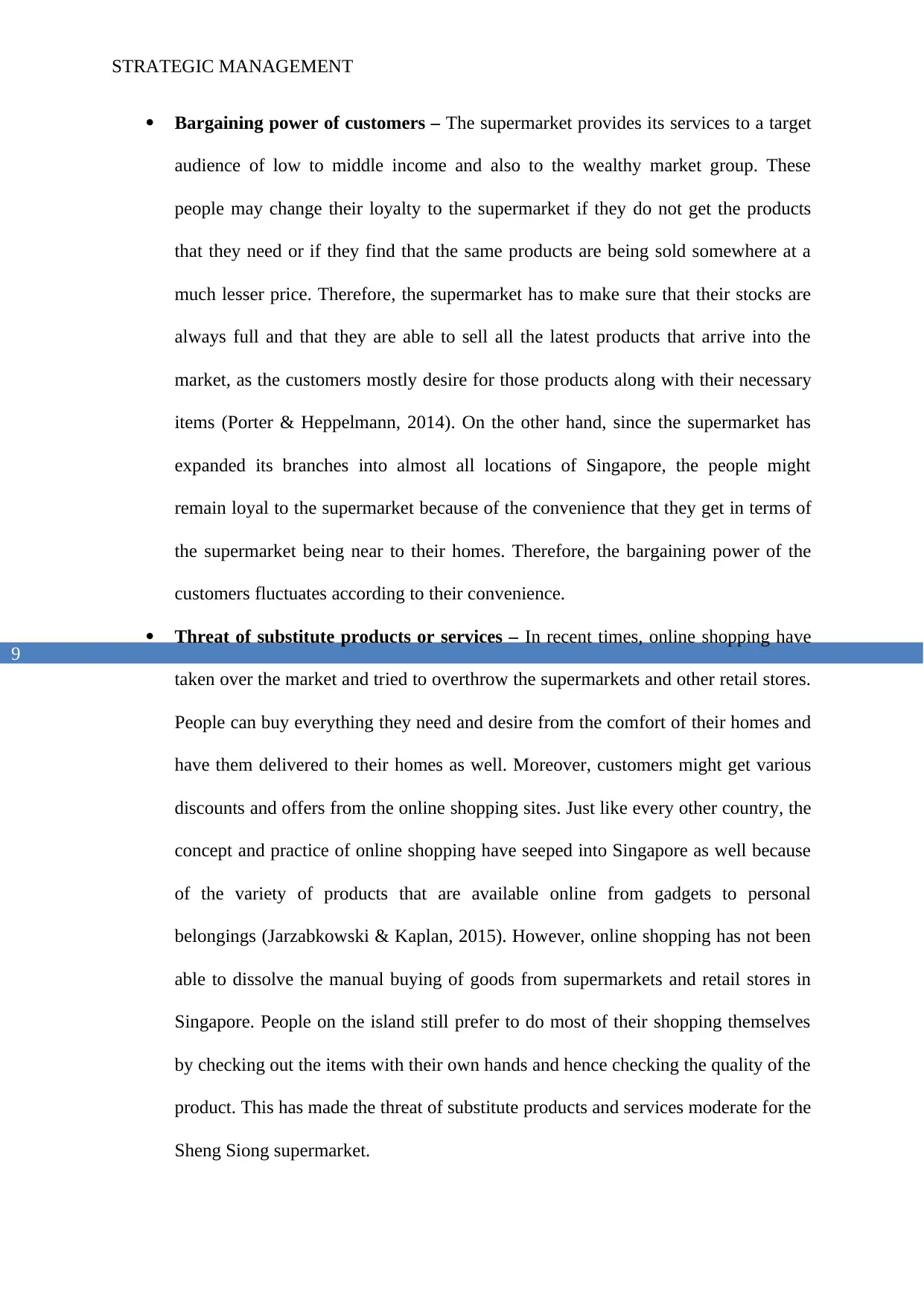
STRATEGIC MANAGEMENT
Bargaining power of customers – The supermarket provides its services to a target
audience of low to middle income and also to the wealthy market group. These
people may change their loyalty to the supermarket if they do not get the products
that they need or if they find that the same products are being sold somewhere at a
much lesser price. Therefore, the supermarket has to make sure that their stocks are
always full and that they are able to sell all the latest products that arrive into the
market, as the customers mostly desire for those products along with their necessary
items (Porter & Heppelmann, 2014). On the other hand, since the supermarket has
expanded its branches into almost all locations of Singapore, the people might
remain loyal to the supermarket because of the convenience that they get in terms of
the supermarket being near to their homes. Therefore, the bargaining power of the
customers fluctuates according to their convenience.
Threat of substitute products or services – In recent times, online shopping have
taken over the market and tried to overthrow the supermarkets and other retail stores.
People can buy everything they need and desire from the comfort of their homes and
have them delivered to their homes as well. Moreover, customers might get various
discounts and offers from the online shopping sites. Just like every other country, the
concept and practice of online shopping have seeped into Singapore as well because
of the variety of products that are available online from gadgets to personal
belongings (Jarzabkowski & Kaplan, 2015). However, online shopping has not been
able to dissolve the manual buying of goods from supermarkets and retail stores in
Singapore. People on the island still prefer to do most of their shopping themselves
by checking out the items with their own hands and hence checking the quality of the
product. This has made the threat of substitute products and services moderate for the
Sheng Siong supermarket.
Paraphrase This Document
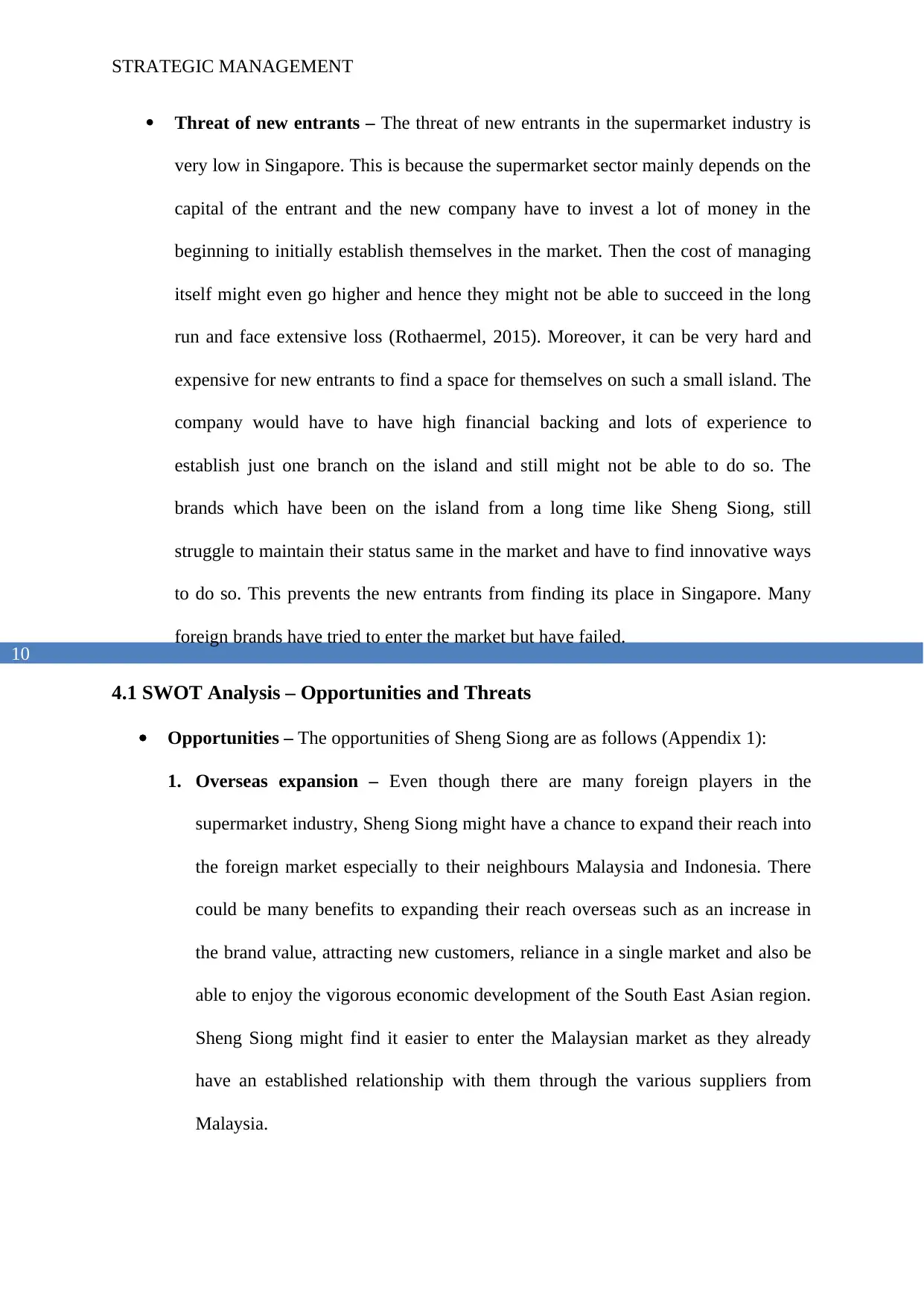
STRATEGIC MANAGEMENT
Threat of new entrants – The threat of new entrants in the supermarket industry is
very low in Singapore. This is because the supermarket sector mainly depends on the
capital of the entrant and the new company have to invest a lot of money in the
beginning to initially establish themselves in the market. Then the cost of managing
itself might even go higher and hence they might not be able to succeed in the long
run and face extensive loss (Rothaermel, 2015). Moreover, it can be very hard and
expensive for new entrants to find a space for themselves on such a small island. The
company would have to have high financial backing and lots of experience to
establish just one branch on the island and still might not be able to do so. The
brands which have been on the island from a long time like Sheng Siong, still
struggle to maintain their status same in the market and have to find innovative ways
to do so. This prevents the new entrants from finding its place in Singapore. Many
foreign brands have tried to enter the market but have failed.
4.1 SWOT Analysis – Opportunities and Threats
Opportunities – The opportunities of Sheng Siong are as follows (Appendix 1):
1. Overseas expansion – Even though there are many foreign players in the
supermarket industry, Sheng Siong might have a chance to expand their reach into
the foreign market especially to their neighbours Malaysia and Indonesia. There
could be many benefits to expanding their reach overseas such as an increase in
the brand value, attracting new customers, reliance in a single market and also be
able to enjoy the vigorous economic development of the South East Asian region.
Sheng Siong might find it easier to enter the Malaysian market as they already
have an established relationship with them through the various suppliers from
Malaysia.
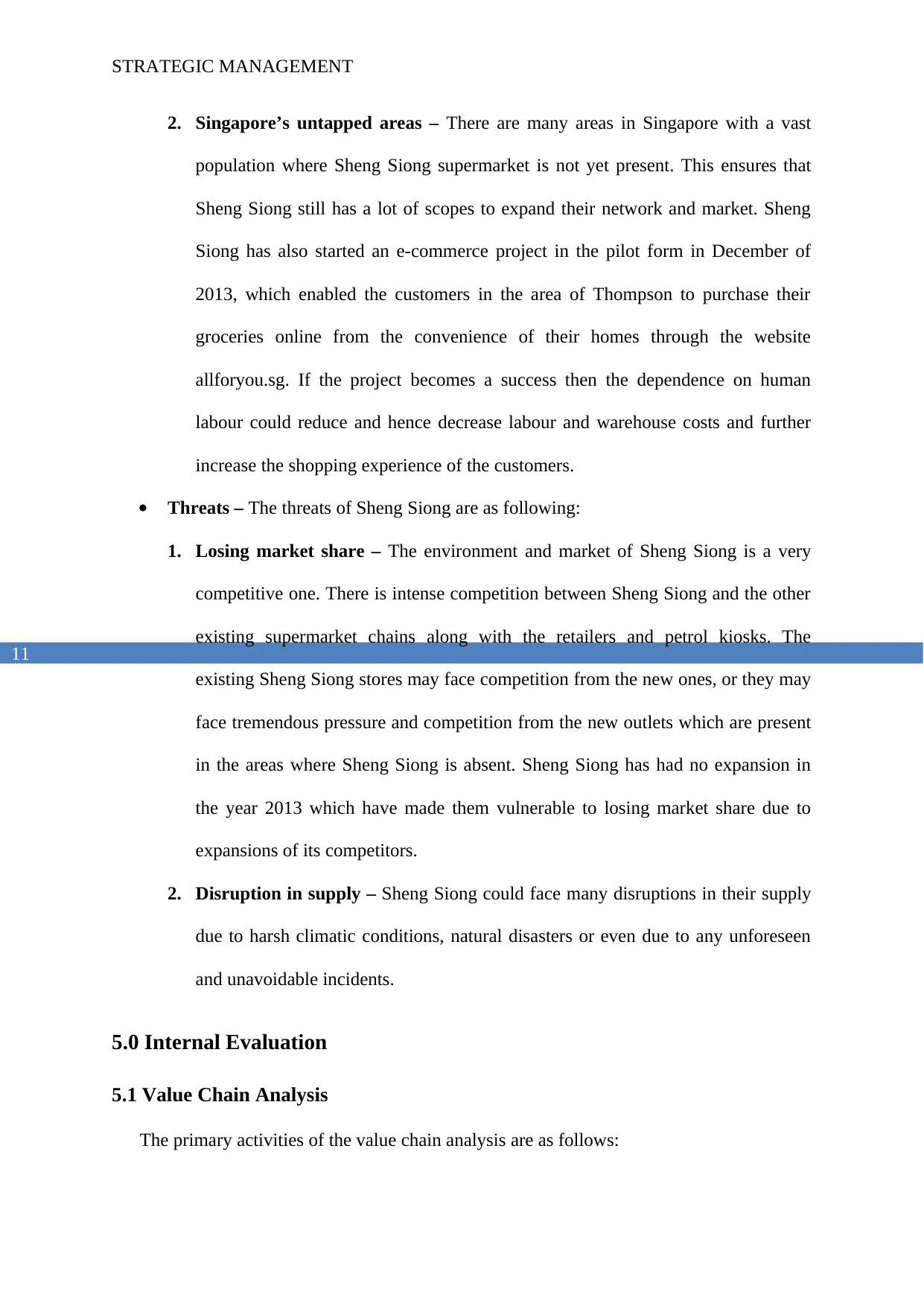
STRATEGIC MANAGEMENT
2. Singapore’s untapped areas – There are many areas in Singapore with a vast
population where Sheng Siong supermarket is not yet present. This ensures that
Sheng Siong still has a lot of scopes to expand their network and market. Sheng
Siong has also started an e-commerce project in the pilot form in December of
2013, which enabled the customers in the area of Thompson to purchase their
groceries online from the convenience of their homes through the website
allforyou.sg. If the project becomes a success then the dependence on human
labour could reduce and hence decrease labour and warehouse costs and further
increase the shopping experience of the customers.
Threats – The threats of Sheng Siong are as following:
1. Losing market share – The environment and market of Sheng Siong is a very
competitive one. There is intense competition between Sheng Siong and the other
existing supermarket chains along with the retailers and petrol kiosks. The
existing Sheng Siong stores may face competition from the new ones, or they may
face tremendous pressure and competition from the new outlets which are present
in the areas where Sheng Siong is absent. Sheng Siong has had no expansion in
the year 2013 which have made them vulnerable to losing market share due to
expansions of its competitors.
2. Disruption in supply – Sheng Siong could face many disruptions in their supply
due to harsh climatic conditions, natural disasters or even due to any unforeseen
and unavoidable incidents.
5.0 Internal Evaluation
5.1 Value Chain Analysis
The primary activities of the value chain analysis are as follows:
⊘ This is a preview!⊘
Do you want full access?
Subscribe today to unlock all pages.

Trusted by 1+ million students worldwide
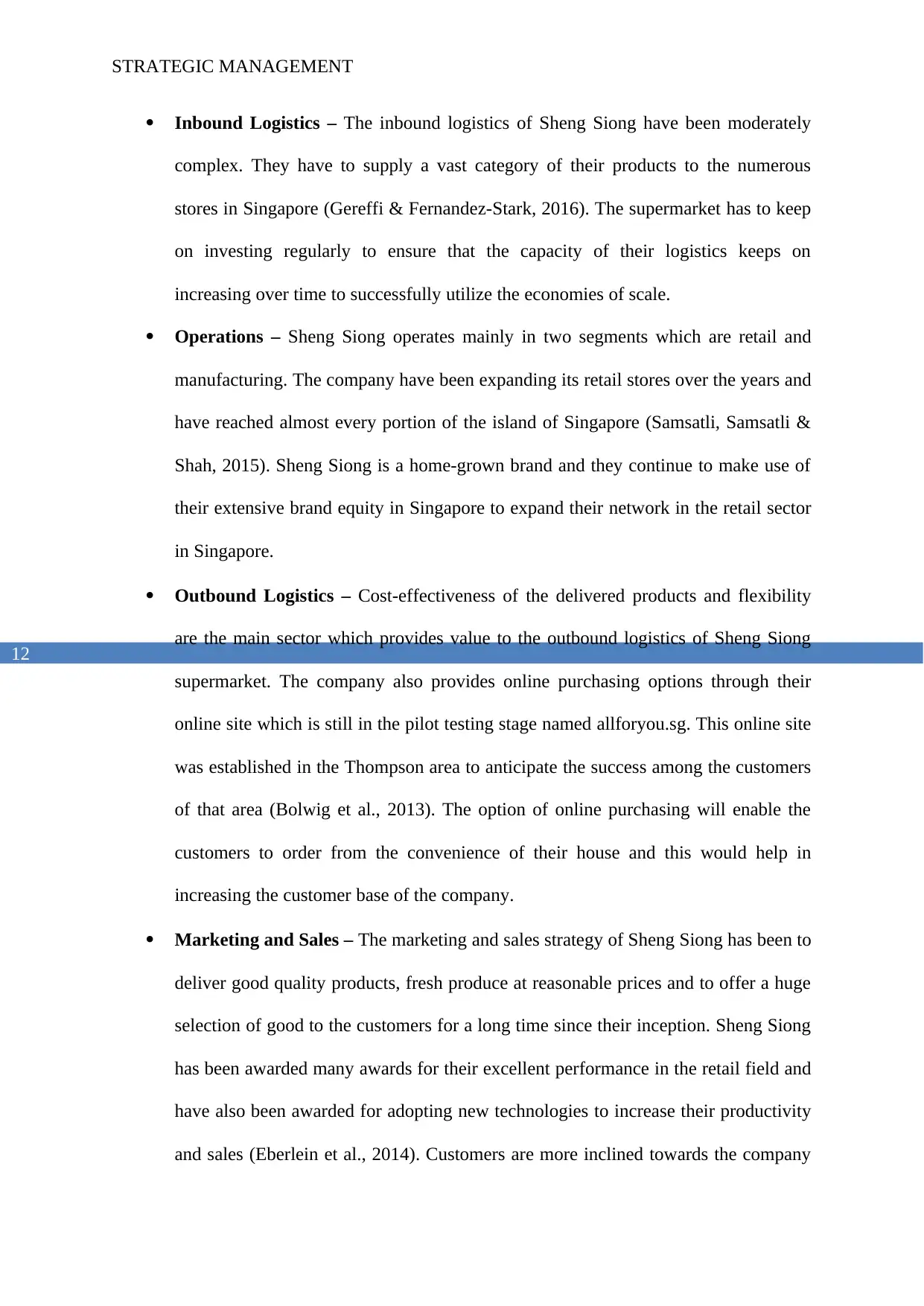
STRATEGIC MANAGEMENT
Inbound Logistics – The inbound logistics of Sheng Siong have been moderately
complex. They have to supply a vast category of their products to the numerous
stores in Singapore (Gereffi & Fernandez-Stark, 2016). The supermarket has to keep
on investing regularly to ensure that the capacity of their logistics keeps on
increasing over time to successfully utilize the economies of scale.
Operations – Sheng Siong operates mainly in two segments which are retail and
manufacturing. The company have been expanding its retail stores over the years and
have reached almost every portion of the island of Singapore (Samsatli, Samsatli &
Shah, 2015). Sheng Siong is a home-grown brand and they continue to make use of
their extensive brand equity in Singapore to expand their network in the retail sector
in Singapore.
Outbound Logistics – Cost-effectiveness of the delivered products and flexibility
are the main sector which provides value to the outbound logistics of Sheng Siong
supermarket. The company also provides online purchasing options through their
online site which is still in the pilot testing stage named allforyou.sg. This online site
was established in the Thompson area to anticipate the success among the customers
of that area (Bolwig et al., 2013). The option of online purchasing will enable the
customers to order from the convenience of their house and this would help in
increasing the customer base of the company.
Marketing and Sales – The marketing and sales strategy of Sheng Siong has been to
deliver good quality products, fresh produce at reasonable prices and to offer a huge
selection of good to the customers for a long time since their inception. Sheng Siong
has been awarded many awards for their excellent performance in the retail field and
have also been awarded for adopting new technologies to increase their productivity
and sales (Eberlein et al., 2014). Customers are more inclined towards the company
Paraphrase This Document
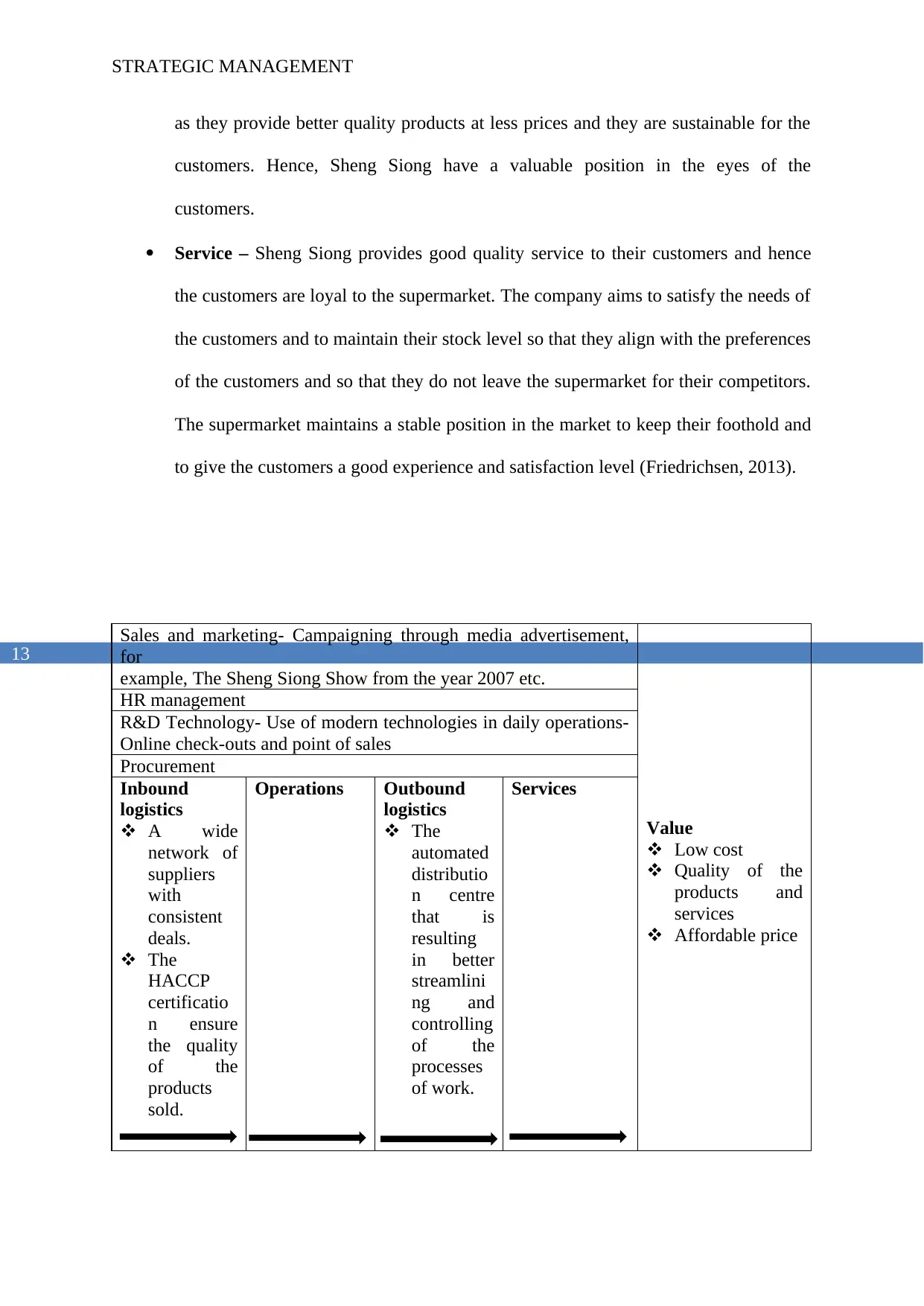
STRATEGIC MANAGEMENT
as they provide better quality products at less prices and they are sustainable for the
customers. Hence, Sheng Siong have a valuable position in the eyes of the
customers.
Service – Sheng Siong provides good quality service to their customers and hence
the customers are loyal to the supermarket. The company aims to satisfy the needs of
the customers and to maintain their stock level so that they align with the preferences
of the customers and so that they do not leave the supermarket for their competitors.
The supermarket maintains a stable position in the market to keep their foothold and
to give the customers a good experience and satisfaction level (Friedrichsen, 2013).
Sales and marketing- Campaigning through media advertisement,
for
example, The Sheng Siong Show from the year 2007 etc.
Value
Low cost
Quality of the
products and
services
Affordable price
HR management
R&D Technology- Use of modern technologies in daily operations-
Online check-outs and point of sales
Procurement
Inbound
logistics
A wide
network of
suppliers
with
consistent
deals.
The
HACCP
certificatio
n ensure
the quality
of the
products
sold.
Operations Outbound
logistics
The
automated
distributio
n centre
that is
resulting
in better
streamlini
ng and
controlling
of the
processes
of work.
Services
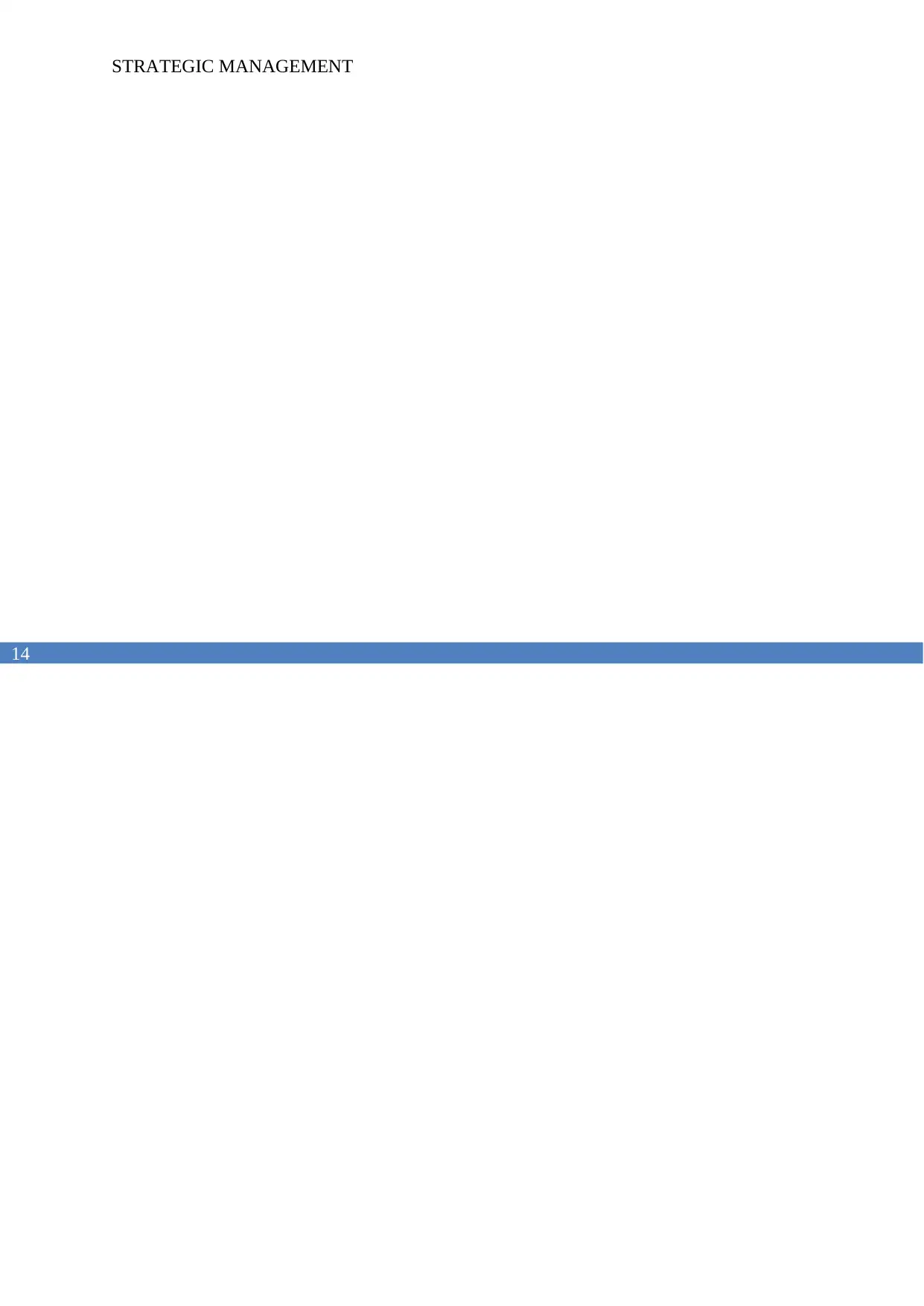
STRATEGIC MANAGEMENT
⊘ This is a preview!⊘
Do you want full access?
Subscribe today to unlock all pages.

Trusted by 1+ million students worldwide

STRATEGIC MANAGEMENT
5.2 SWOT Analysis – Strengths and Weakness
The SWOT analysis for Sheng Siong supermarket is as follows (Appendix 1):
Strengths – The strengths of Sheng Siong supermarket are:
1. Strong brand recognition – Sheng Siong supermarket have been functioning in
Singapore for a long time and has placed itself among the top 3 chains of
supermarket in Singapore. Therefore, it has a very strong brand recognition
among the people of Singapore. The supermarket have been awarded the status of
Superbrand by Superbands Singapore which is a global organization that awards
the most recognized and valued brands every year. Sheng Siong have also
launched a television show with the title The Sheng Siong show since the year
2007 and have tried to raise their profile along with their other marketing
techniques.
2. Experienced management – The supermarket have been established in the year
1985 and have functioned only in the retail industry of Singapore. Sheng Siong
comprises of a very strong management who has a deep experience in the retailing
sector and contains a very deep knowledge about the industry in Singapore. The
management comprises of three Lim brothers who have founded the Sheng Siong
brand.
Weaknesses – The weaknesses of Sheng Siong is as follows:
1. Capable of labour cost hikes and rent hikes – The rent and labour costs of
Sheng Siong takes up most of their operating expenses. This high cost could be an
issue for the supermarket as they always try to maintain a low-cost strategy for
their supermarket. There have also been restriction made by the Singapore
government against the hiring of foreign labour which puts a huge pressure on
Sheng Siong as a large portion of their employees consisted of non-Singaporeans.
Paraphrase This Document
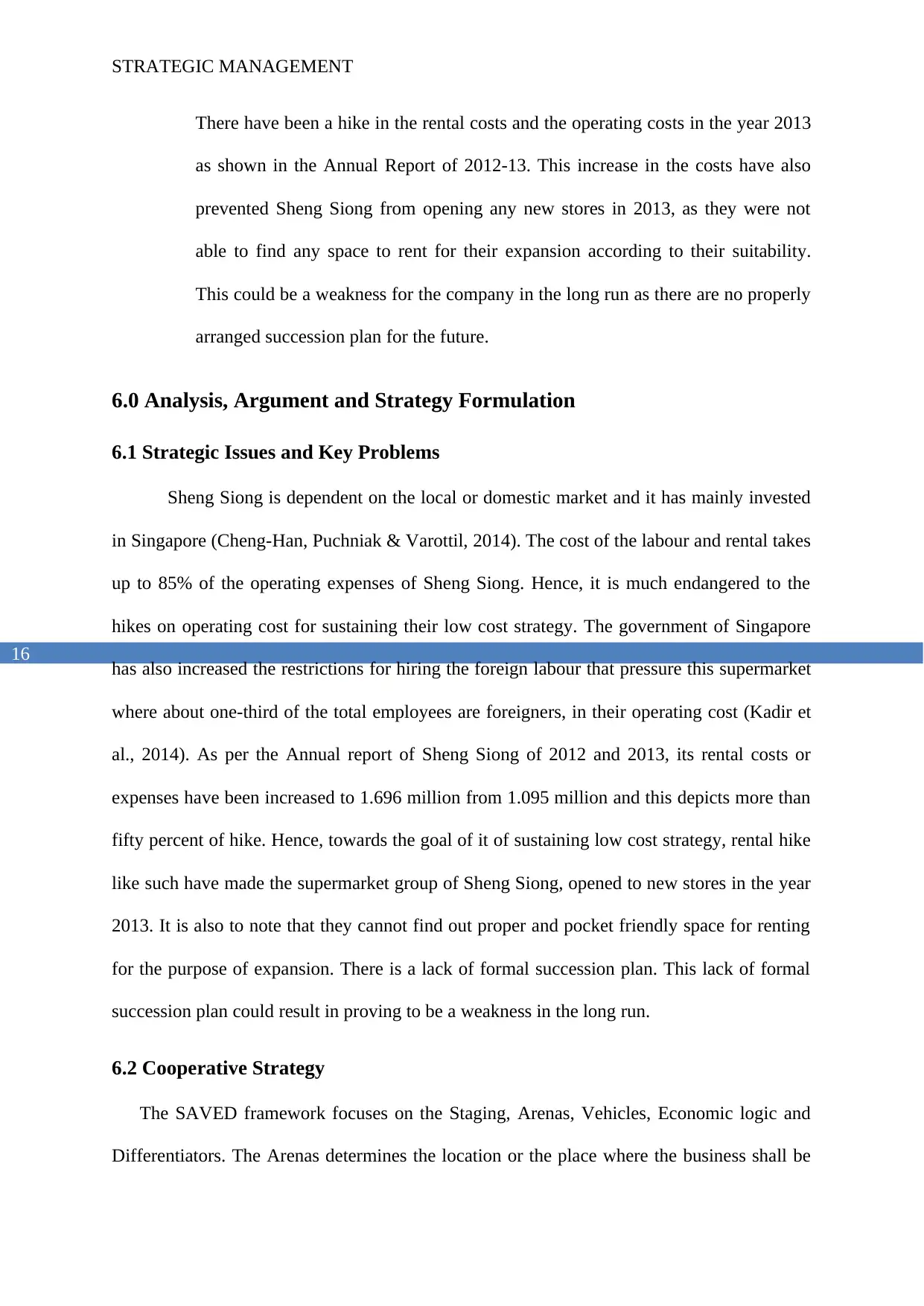
STRATEGIC MANAGEMENT
There have been a hike in the rental costs and the operating costs in the year 2013
as shown in the Annual Report of 2012-13. This increase in the costs have also
prevented Sheng Siong from opening any new stores in 2013, as they were not
able to find any space to rent for their expansion according to their suitability.
This could be a weakness for the company in the long run as there are no properly
arranged succession plan for the future.
6.0 Analysis, Argument and Strategy Formulation
6.1 Strategic Issues and Key Problems
Sheng Siong is dependent on the local or domestic market and it has mainly invested
in Singapore (Cheng-Han, Puchniak & Varottil, 2014). The cost of the labour and rental takes
up to 85% of the operating expenses of Sheng Siong. Hence, it is much endangered to the
hikes on operating cost for sustaining their low cost strategy. The government of Singapore
has also increased the restrictions for hiring the foreign labour that pressure this supermarket
where about one-third of the total employees are foreigners, in their operating cost (Kadir et
al., 2014). As per the Annual report of Sheng Siong of 2012 and 2013, its rental costs or
expenses have been increased to 1.696 million from 1.095 million and this depicts more than
fifty percent of hike. Hence, towards the goal of it of sustaining low cost strategy, rental hike
like such have made the supermarket group of Sheng Siong, opened to new stores in the year
2013. It is also to note that they cannot find out proper and pocket friendly space for renting
for the purpose of expansion. There is a lack of formal succession plan. This lack of formal
succession plan could result in proving to be a weakness in the long run.
6.2 Cooperative Strategy
The SAVED framework focuses on the Staging, Arenas, Vehicles, Economic logic and
Differentiators. The Arenas determines the location or the place where the business shall be
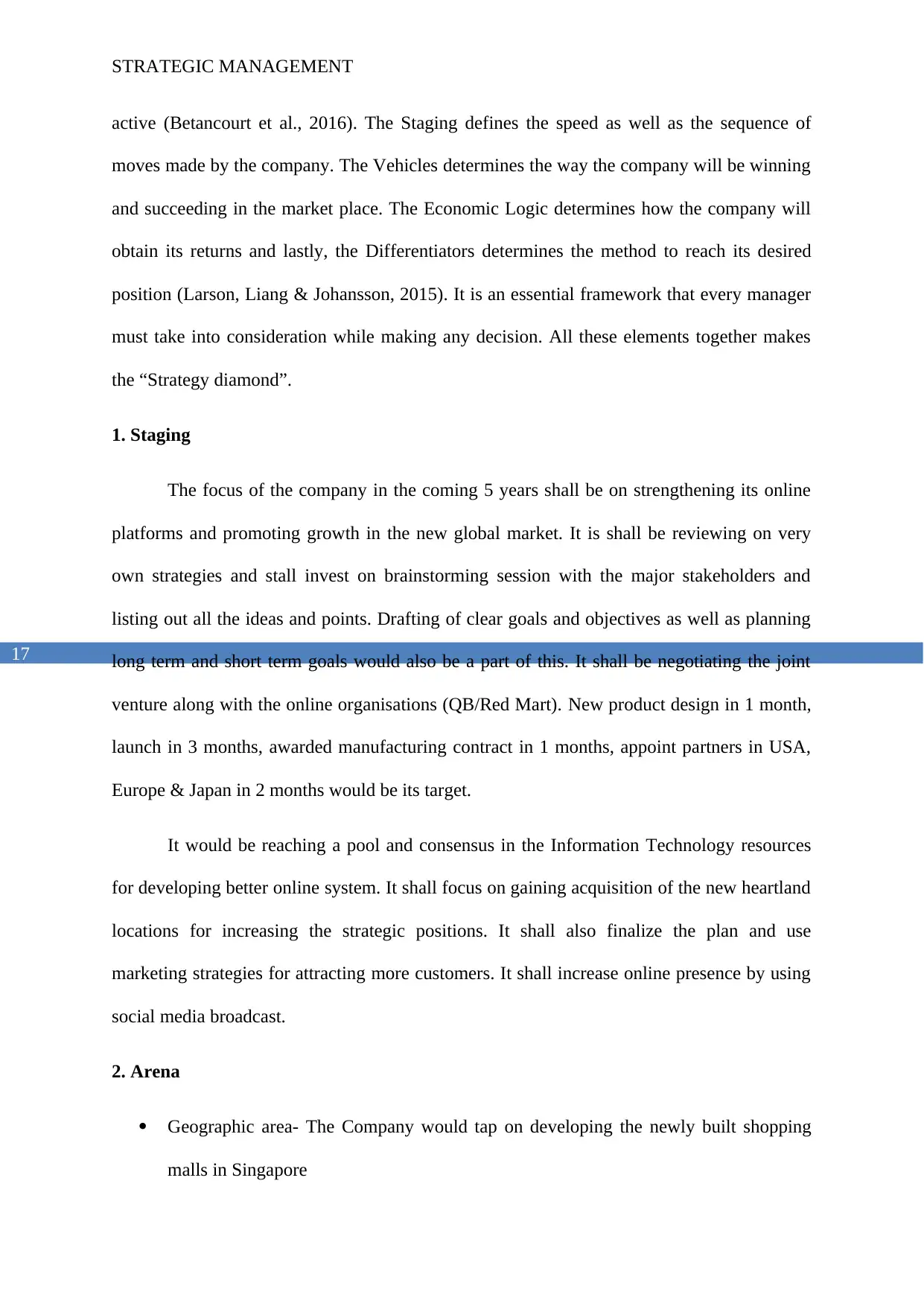
STRATEGIC MANAGEMENT
active (Betancourt et al., 2016). The Staging defines the speed as well as the sequence of
moves made by the company. The Vehicles determines the way the company will be winning
and succeeding in the market place. The Economic Logic determines how the company will
obtain its returns and lastly, the Differentiators determines the method to reach its desired
position (Larson, Liang & Johansson, 2015). It is an essential framework that every manager
must take into consideration while making any decision. All these elements together makes
the “Strategy diamond”.
1. Staging
The focus of the company in the coming 5 years shall be on strengthening its online
platforms and promoting growth in the new global market. It is shall be reviewing on very
own strategies and stall invest on brainstorming session with the major stakeholders and
listing out all the ideas and points. Drafting of clear goals and objectives as well as planning
long term and short term goals would also be a part of this. It shall be negotiating the joint
venture along with the online organisations (QB/Red Mart). New product design in 1 month,
launch in 3 months, awarded manufacturing contract in 1 months, appoint partners in USA,
Europe & Japan in 2 months would be its target.
It would be reaching a pool and consensus in the Information Technology resources
for developing better online system. It shall focus on gaining acquisition of the new heartland
locations for increasing the strategic positions. It shall also finalize the plan and use
marketing strategies for attracting more customers. It shall increase online presence by using
social media broadcast.
2. Arena
Geographic area- The Company would tap on developing the newly built shopping
malls in Singapore
⊘ This is a preview!⊘
Do you want full access?
Subscribe today to unlock all pages.

Trusted by 1+ million students worldwide
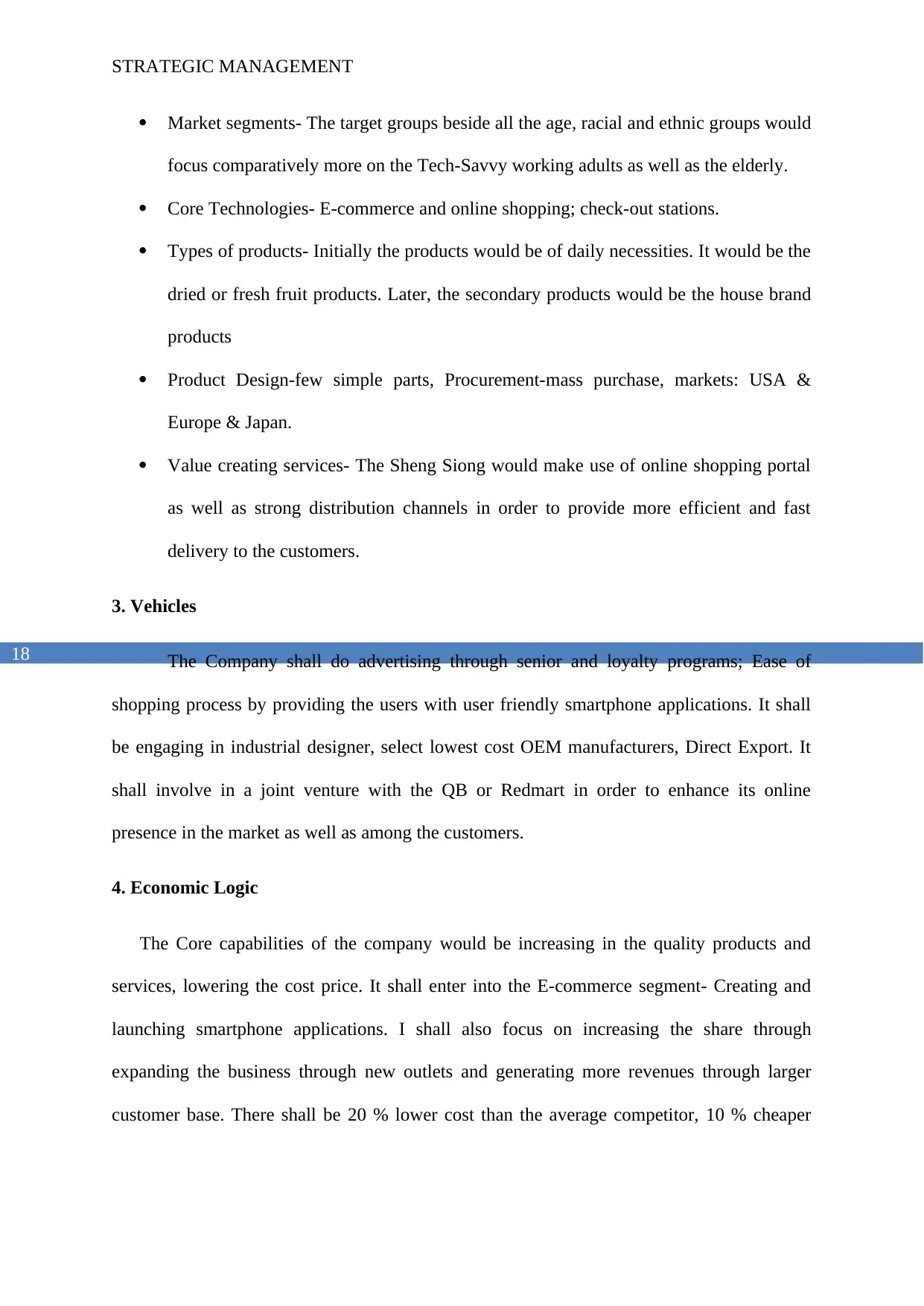
STRATEGIC MANAGEMENT
Market segments- The target groups beside all the age, racial and ethnic groups would
focus comparatively more on the Tech-Savvy working adults as well as the elderly.
Core Technologies- E-commerce and online shopping; check-out stations.
Types of products- Initially the products would be of daily necessities. It would be the
dried or fresh fruit products. Later, the secondary products would be the house brand
products
Product Design-few simple parts, Procurement-mass purchase, markets: USA &
Europe & Japan.
Value creating services- The Sheng Siong would make use of online shopping portal
as well as strong distribution channels in order to provide more efficient and fast
delivery to the customers.
3. Vehicles
The Company shall do advertising through senior and loyalty programs; Ease of
shopping process by providing the users with user friendly smartphone applications. It shall
be engaging in industrial designer, select lowest cost OEM manufacturers, Direct Export. It
shall involve in a joint venture with the QB or Redmart in order to enhance its online
presence in the market as well as among the customers.
4. Economic Logic
The Core capabilities of the company would be increasing in the quality products and
services, lowering the cost price. It shall enter into the E-commerce segment- Creating and
launching smartphone applications. I shall also focus on increasing the share through
expanding the business through new outlets and generating more revenues through larger
customer base. There shall be 20 % lower cost than the average competitor, 10 % cheaper
Paraphrase This Document
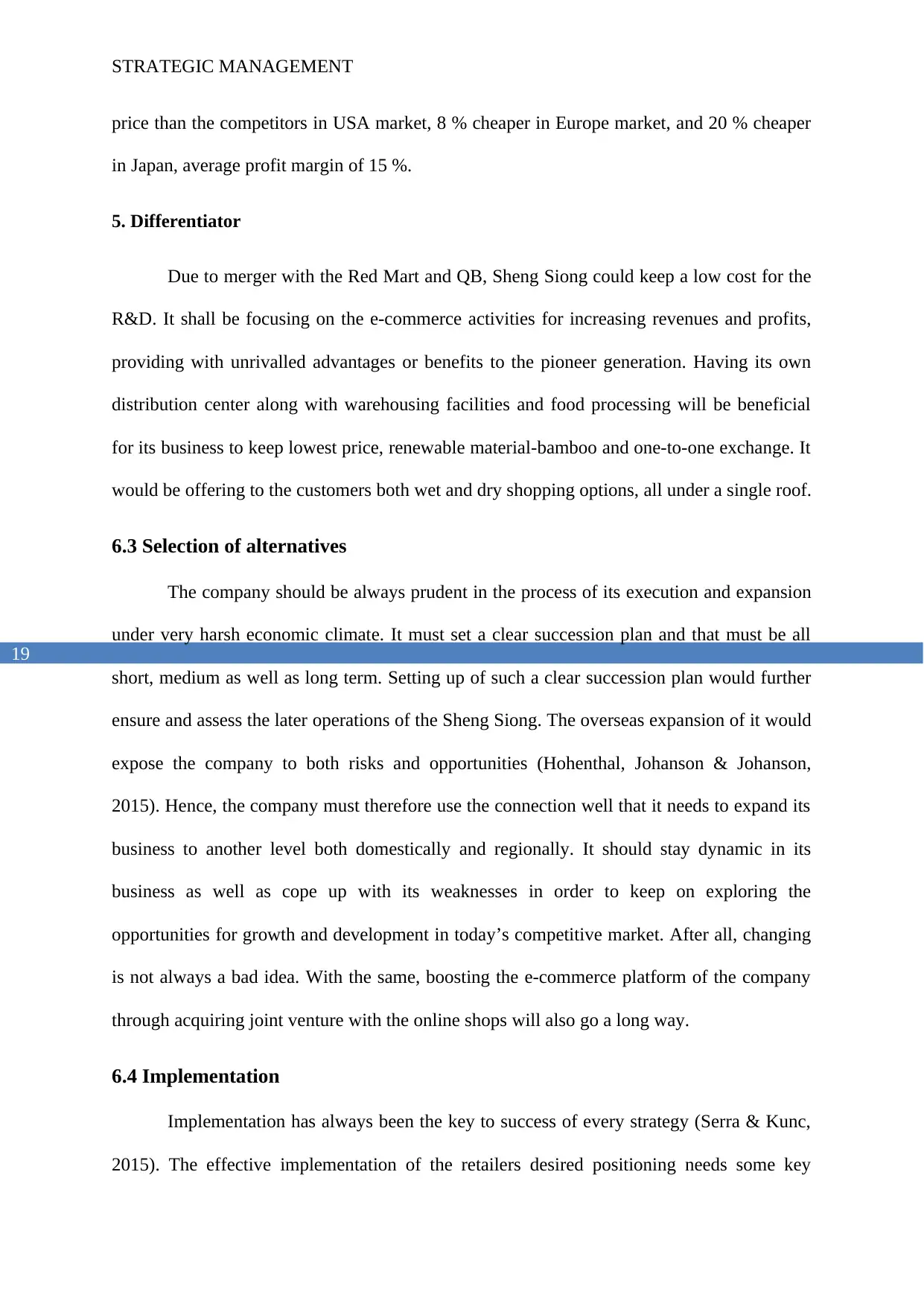
STRATEGIC MANAGEMENT
price than the competitors in USA market, 8 % cheaper in Europe market, and 20 % cheaper
in Japan, average profit margin of 15 %.
5. Differentiator
Due to merger with the Red Mart and QB, Sheng Siong could keep a low cost for the
R&D. It shall be focusing on the e-commerce activities for increasing revenues and profits,
providing with unrivalled advantages or benefits to the pioneer generation. Having its own
distribution center along with warehousing facilities and food processing will be beneficial
for its business to keep lowest price, renewable material-bamboo and one-to-one exchange. It
would be offering to the customers both wet and dry shopping options, all under a single roof.
6.3 Selection of alternatives
The company should be always prudent in the process of its execution and expansion
under very harsh economic climate. It must set a clear succession plan and that must be all
short, medium as well as long term. Setting up of such a clear succession plan would further
ensure and assess the later operations of the Sheng Siong. The overseas expansion of it would
expose the company to both risks and opportunities (Hohenthal, Johanson & Johanson,
2015). Hence, the company must therefore use the connection well that it needs to expand its
business to another level both domestically and regionally. It should stay dynamic in its
business as well as cope up with its weaknesses in order to keep on exploring the
opportunities for growth and development in today’s competitive market. After all, changing
is not always a bad idea. With the same, boosting the e-commerce platform of the company
through acquiring joint venture with the online shops will also go a long way.
6.4 Implementation
Implementation has always been the key to success of every strategy (Serra & Kunc,
2015). The effective implementation of the retailers desired positioning needs some key
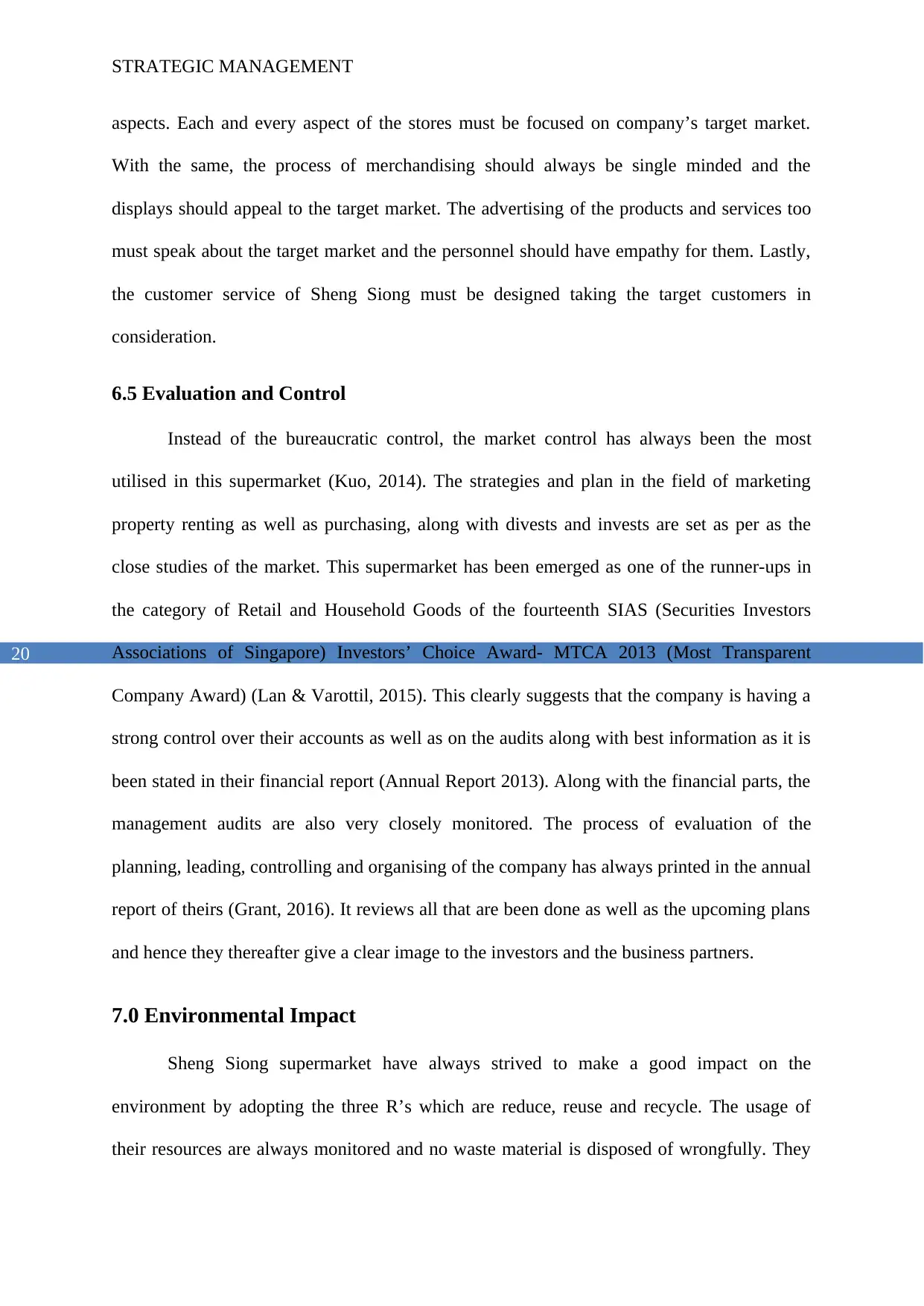
STRATEGIC MANAGEMENT
aspects. Each and every aspect of the stores must be focused on company’s target market.
With the same, the process of merchandising should always be single minded and the
displays should appeal to the target market. The advertising of the products and services too
must speak about the target market and the personnel should have empathy for them. Lastly,
the customer service of Sheng Siong must be designed taking the target customers in
consideration.
6.5 Evaluation and Control
Instead of the bureaucratic control, the market control has always been the most
utilised in this supermarket (Kuo, 2014). The strategies and plan in the field of marketing
property renting as well as purchasing, along with divests and invests are set as per as the
close studies of the market. This supermarket has been emerged as one of the runner-ups in
the category of Retail and Household Goods of the fourteenth SIAS (Securities Investors
Associations of Singapore) Investors’ Choice Award- MTCA 2013 (Most Transparent
Company Award) (Lan & Varottil, 2015). This clearly suggests that the company is having a
strong control over their accounts as well as on the audits along with best information as it is
been stated in their financial report (Annual Report 2013). Along with the financial parts, the
management audits are also very closely monitored. The process of evaluation of the
planning, leading, controlling and organising of the company has always printed in the annual
report of theirs (Grant, 2016). It reviews all that are been done as well as the upcoming plans
and hence they thereafter give a clear image to the investors and the business partners.
7.0 Environmental Impact
Sheng Siong supermarket have always strived to make a good impact on the
environment by adopting the three R’s which are reduce, reuse and recycle. The usage of
their resources are always monitored and no waste material is disposed of wrongfully. They
⊘ This is a preview!⊘
Do you want full access?
Subscribe today to unlock all pages.

Trusted by 1+ million students worldwide
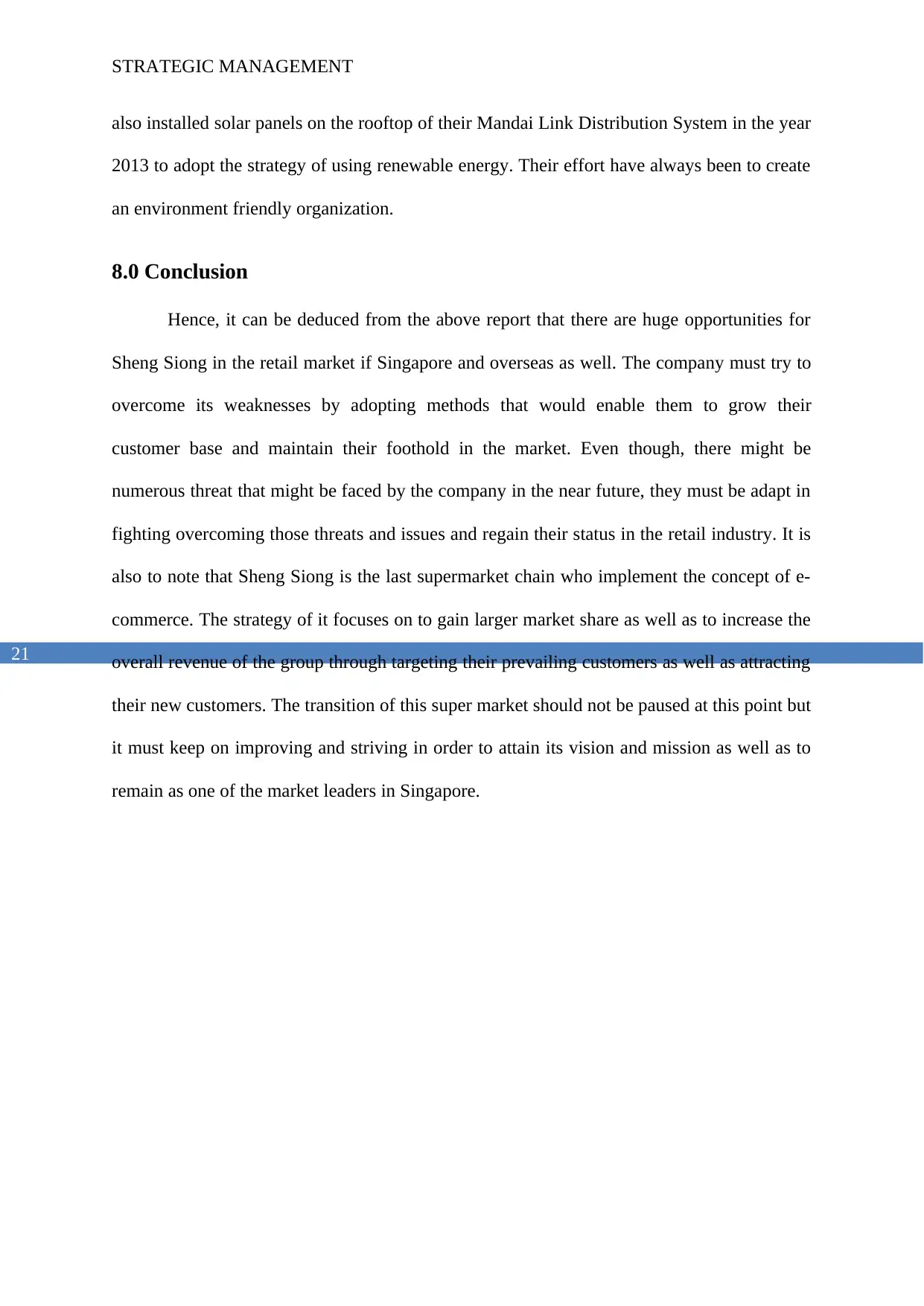
STRATEGIC MANAGEMENT
also installed solar panels on the rooftop of their Mandai Link Distribution System in the year
2013 to adopt the strategy of using renewable energy. Their effort have always been to create
an environment friendly organization.
8.0 Conclusion
Hence, it can be deduced from the above report that there are huge opportunities for
Sheng Siong in the retail market if Singapore and overseas as well. The company must try to
overcome its weaknesses by adopting methods that would enable them to grow their
customer base and maintain their foothold in the market. Even though, there might be
numerous threat that might be faced by the company in the near future, they must be adapt in
fighting overcoming those threats and issues and regain their status in the retail industry. It is
also to note that Sheng Siong is the last supermarket chain who implement the concept of e-
commerce. The strategy of it focuses on to gain larger market share as well as to increase the
overall revenue of the group through targeting their prevailing customers as well as attracting
their new customers. The transition of this super market should not be paused at this point but
it must keep on improving and striving in order to attain its vision and mission as well as to
remain as one of the market leaders in Singapore.
Paraphrase This Document
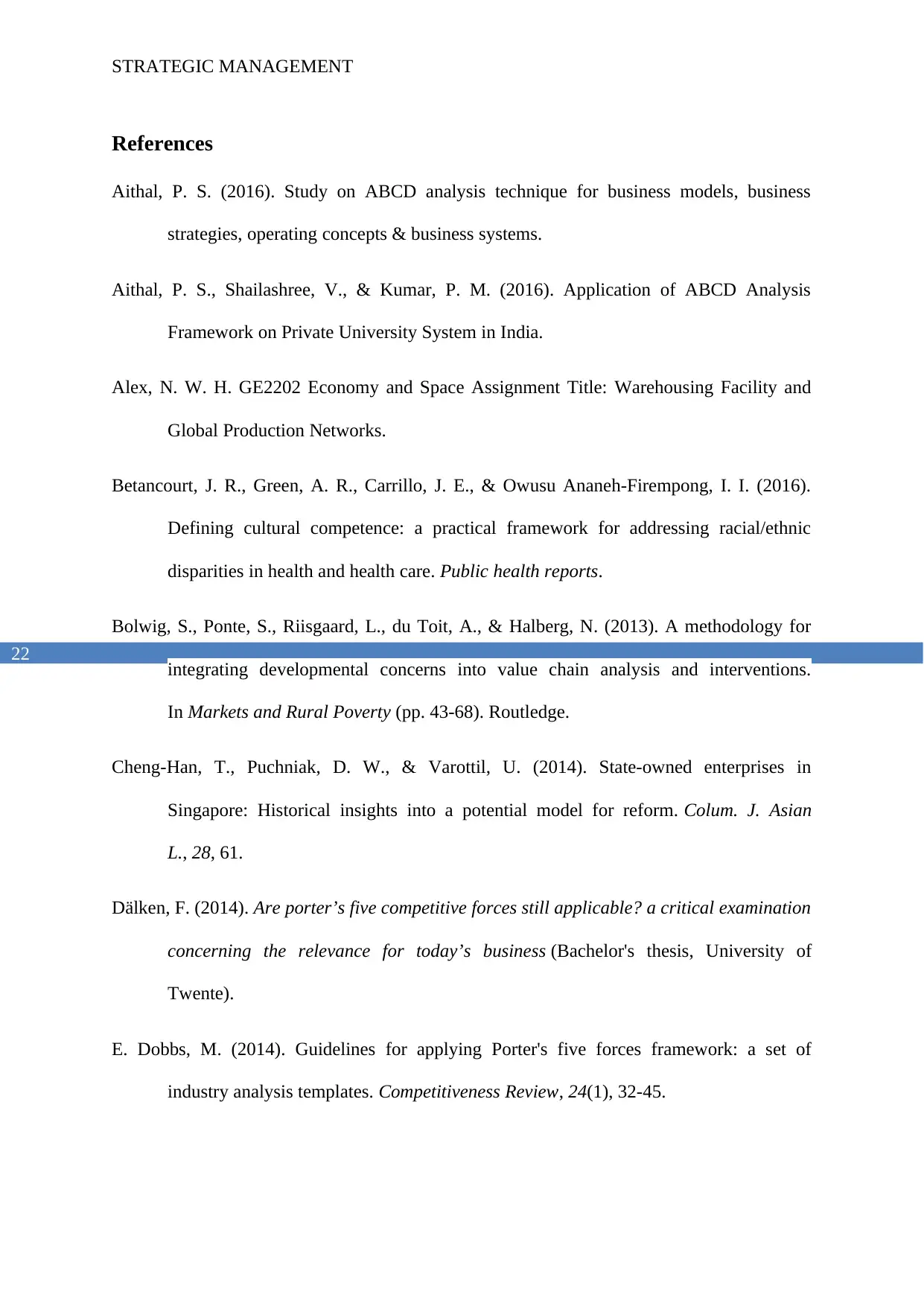
STRATEGIC MANAGEMENT
References
Aithal, P. S. (2016). Study on ABCD analysis technique for business models, business
strategies, operating concepts & business systems.
Aithal, P. S., Shailashree, V., & Kumar, P. M. (2016). Application of ABCD Analysis
Framework on Private University System in India.
Alex, N. W. H. GE2202 Economy and Space Assignment Title: Warehousing Facility and
Global Production Networks.
Betancourt, J. R., Green, A. R., Carrillo, J. E., & Owusu Ananeh-Firempong, I. I. (2016).
Defining cultural competence: a practical framework for addressing racial/ethnic
disparities in health and health care. Public health reports.
Bolwig, S., Ponte, S., Riisgaard, L., du Toit, A., & Halberg, N. (2013). A methodology for
integrating developmental concerns into value chain analysis and interventions.
In Markets and Rural Poverty (pp. 43-68). Routledge.
Cheng-Han, T., Puchniak, D. W., & Varottil, U. (2014). State-owned enterprises in
Singapore: Historical insights into a potential model for reform. Colum. J. Asian
L., 28, 61.
Dälken, F. (2014). Are porter’s five competitive forces still applicable? a critical examination
concerning the relevance for today’s business (Bachelor's thesis, University of
Twente).
E. Dobbs, M. (2014). Guidelines for applying Porter's five forces framework: a set of
industry analysis templates. Competitiveness Review, 24(1), 32-45.
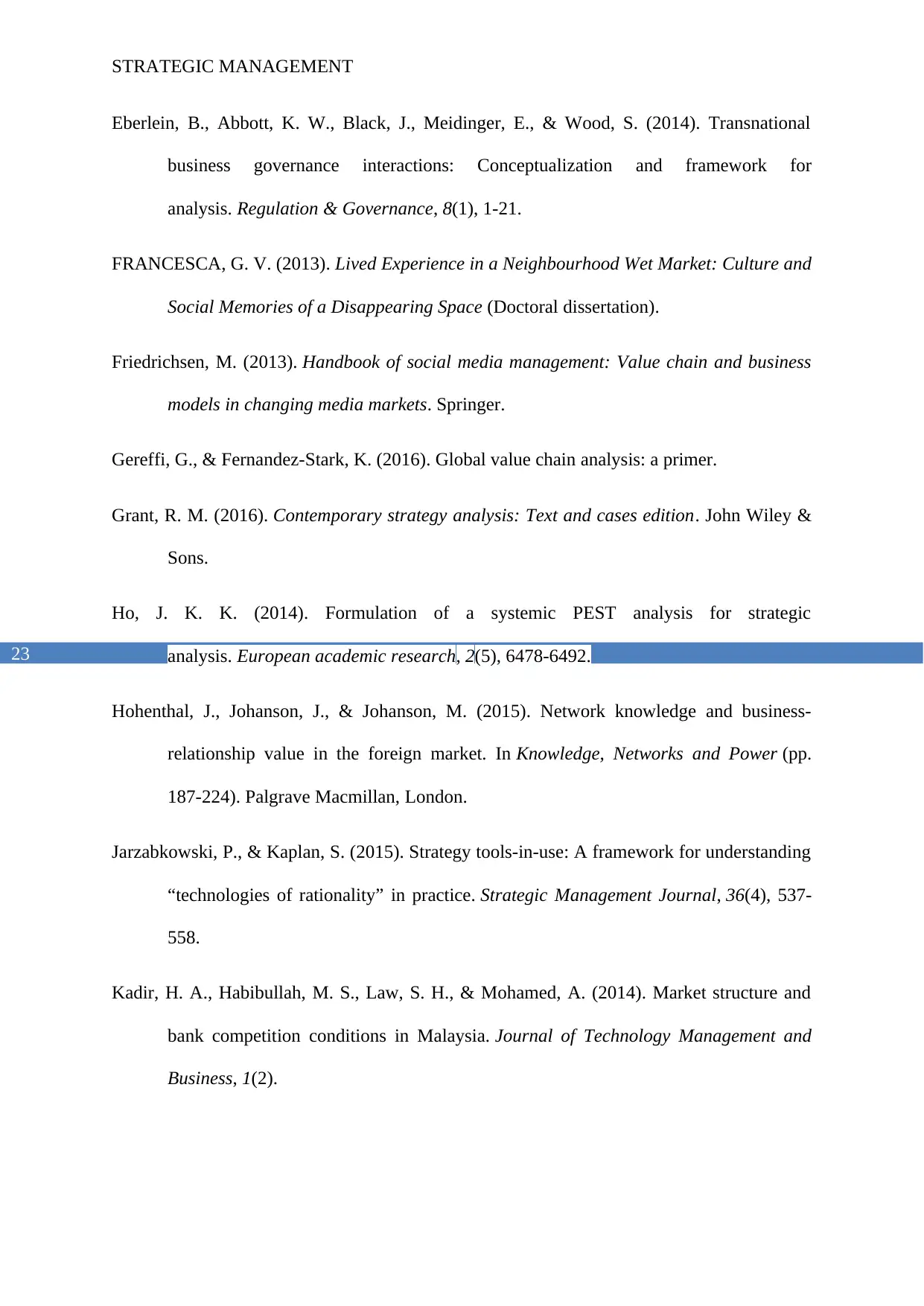
STRATEGIC MANAGEMENT
Eberlein, B., Abbott, K. W., Black, J., Meidinger, E., & Wood, S. (2014). Transnational
business governance interactions: Conceptualization and framework for
analysis. Regulation & Governance, 8(1), 1-21.
FRANCESCA, G. V. (2013). Lived Experience in a Neighbourhood Wet Market: Culture and
Social Memories of a Disappearing Space (Doctoral dissertation).
Friedrichsen, M. (2013). Handbook of social media management: Value chain and business
models in changing media markets. Springer.
Gereffi, G., & Fernandez-Stark, K. (2016). Global value chain analysis: a primer.
Grant, R. M. (2016). Contemporary strategy analysis: Text and cases edition. John Wiley &
Sons.
Ho, J. K. K. (2014). Formulation of a systemic PEST analysis for strategic
analysis. European academic research, 2(5), 6478-6492.
Hohenthal, J., Johanson, J., & Johanson, M. (2015). Network knowledge and business-
relationship value in the foreign market. In Knowledge, Networks and Power (pp.
187-224). Palgrave Macmillan, London.
Jarzabkowski, P., & Kaplan, S. (2015). Strategy tools‐in‐use: A framework for understanding
“technologies of rationality” in practice. Strategic Management Journal, 36(4), 537-
558.
Kadir, H. A., Habibullah, M. S., Law, S. H., & Mohamed, A. (2014). Market structure and
bank competition conditions in Malaysia. Journal of Technology Management and
Business, 1(2).
⊘ This is a preview!⊘
Do you want full access?
Subscribe today to unlock all pages.

Trusted by 1+ million students worldwide
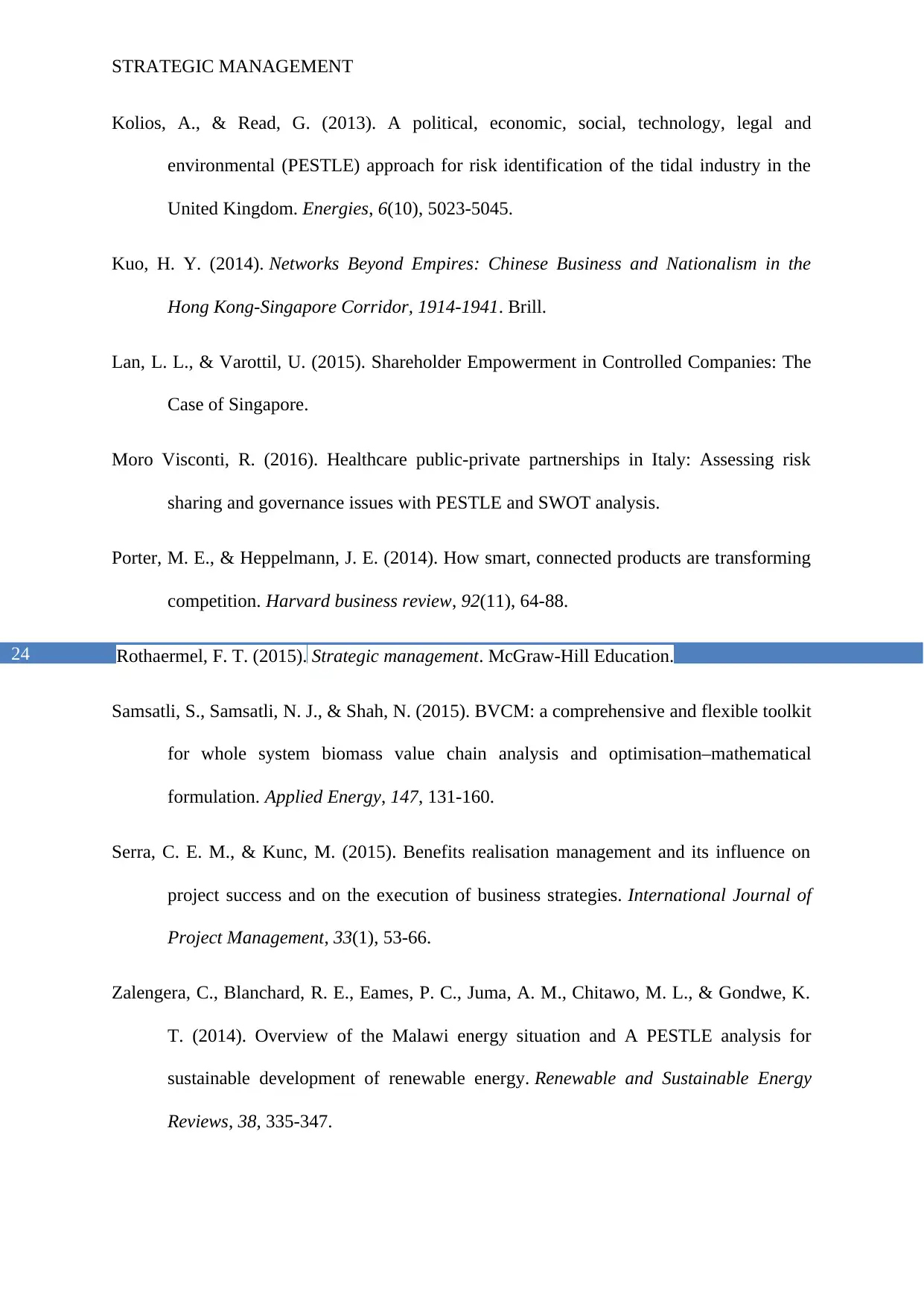
STRATEGIC MANAGEMENT
Kolios, A., & Read, G. (2013). A political, economic, social, technology, legal and
environmental (PESTLE) approach for risk identification of the tidal industry in the
United Kingdom. Energies, 6(10), 5023-5045.
Kuo, H. Y. (2014). Networks Beyond Empires: Chinese Business and Nationalism in the
Hong Kong-Singapore Corridor, 1914-1941. Brill.
Lan, L. L., & Varottil, U. (2015). Shareholder Empowerment in Controlled Companies: The
Case of Singapore.
Moro Visconti, R. (2016). Healthcare public-private partnerships in Italy: Assessing risk
sharing and governance issues with PESTLE and SWOT analysis.
Porter, M. E., & Heppelmann, J. E. (2014). How smart, connected products are transforming
competition. Harvard business review, 92(11), 64-88.
Rothaermel, F. T. (2015). Strategic management. McGraw-Hill Education.
Samsatli, S., Samsatli, N. J., & Shah, N. (2015). BVCM: a comprehensive and flexible toolkit
for whole system biomass value chain analysis and optimisation–mathematical
formulation. Applied Energy, 147, 131-160.
Serra, C. E. M., & Kunc, M. (2015). Benefits realisation management and its influence on
project success and on the execution of business strategies. International Journal of
Project Management, 33(1), 53-66.
Zalengera, C., Blanchard, R. E., Eames, P. C., Juma, A. M., Chitawo, M. L., & Gondwe, K.
T. (2014). Overview of the Malawi energy situation and A PESTLE analysis for
sustainable development of renewable energy. Renewable and Sustainable Energy
Reviews, 38, 335-347.
Paraphrase This Document
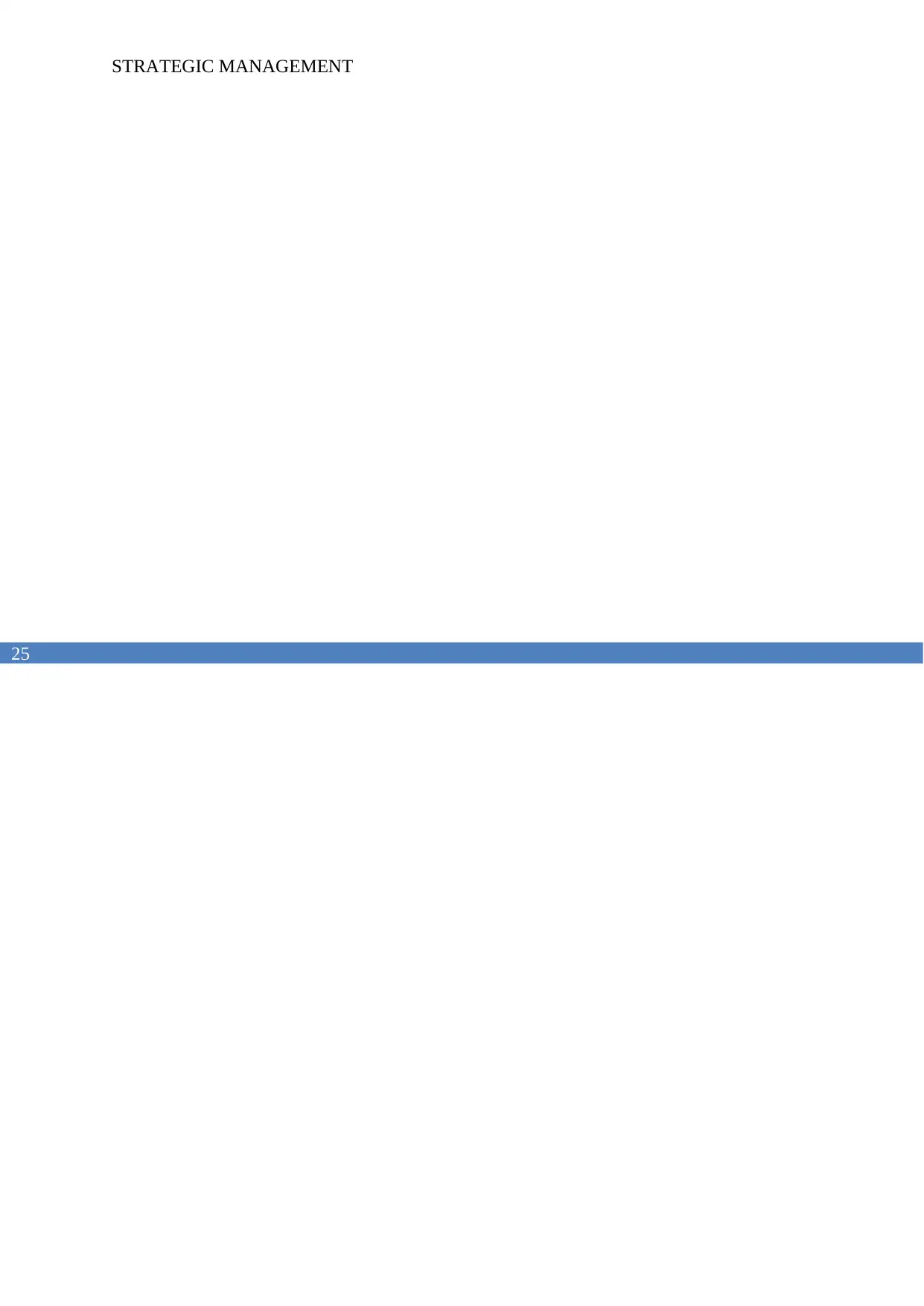
STRATEGIC MANAGEMENT

STRATEGIC MANAGEMENT
Appendix
1. SWOT Analysis
STRENGTH
Strong brand recognition
Experienced management
WEAKNESSES
Capable of labour cost
hikes and rent hikes
OPPORTUNITIES
Overseas expansion
Singapore’s untapped
areas
THREATS
Losing market share
Disruption in supply
2. PESTLE Analysis
⊘ This is a preview!⊘
Do you want full access?
Subscribe today to unlock all pages.

Trusted by 1+ million students worldwide
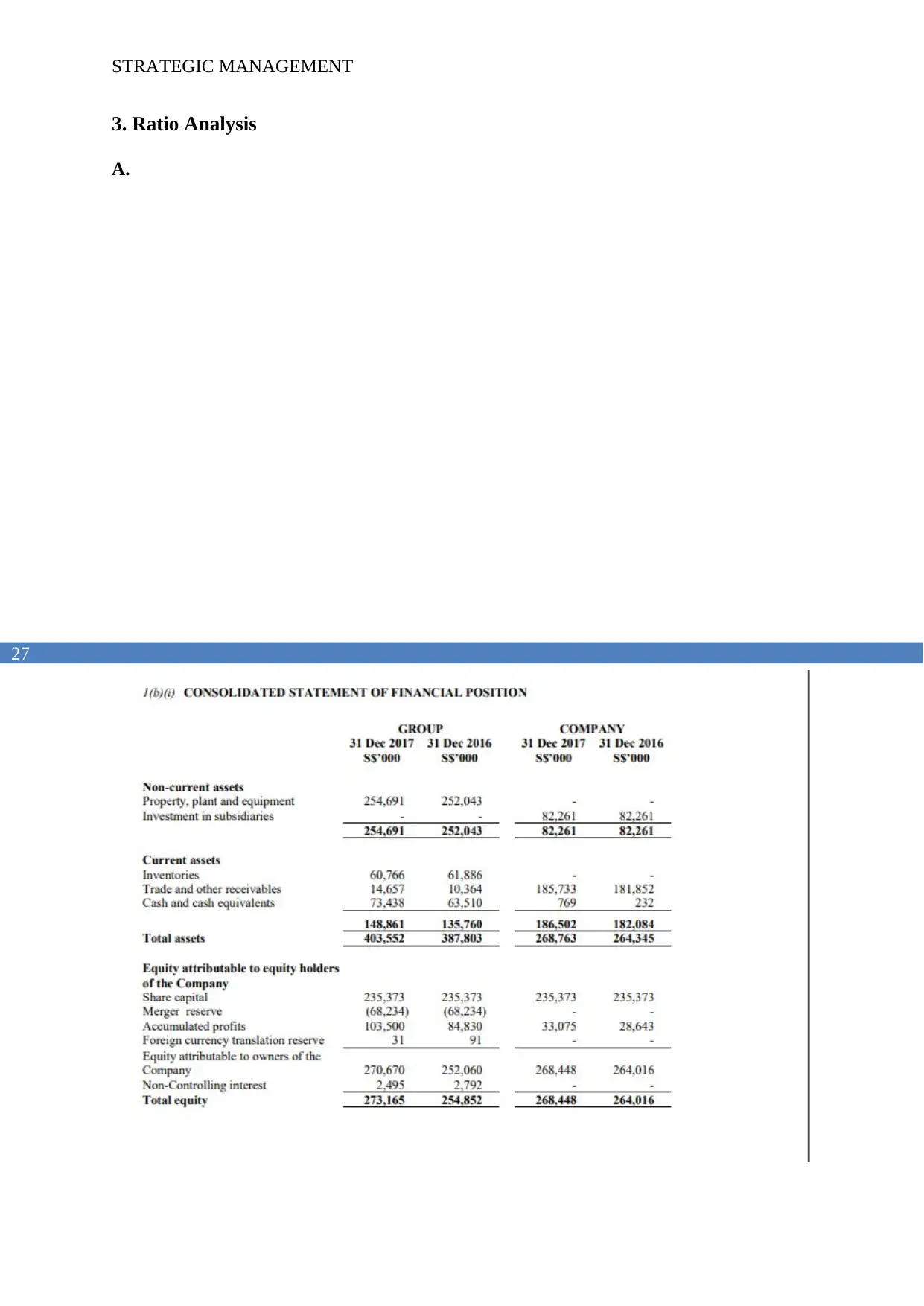
STRATEGIC MANAGEMENT
3. Ratio Analysis
A.
Paraphrase This Document
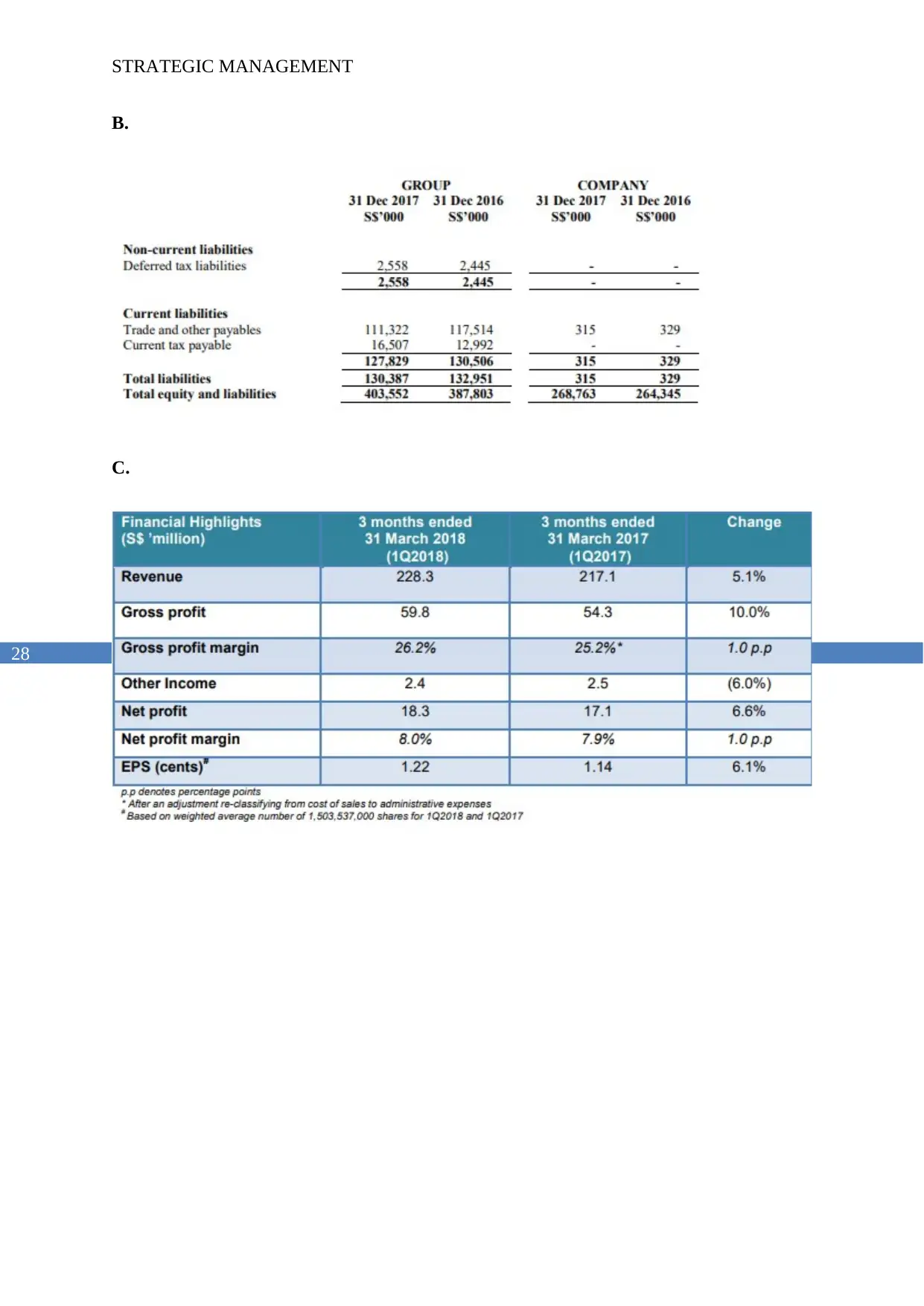
STRATEGIC MANAGEMENT
B.
C.